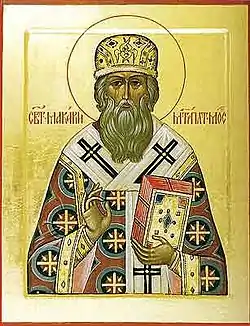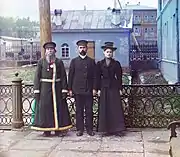List of Russian saints (until 15th century)
Saints in the Russian Orthodox Church are confirmed by canonization which lists the decedent into the Community of Saints. After canonization, the saint is usually listed in the Menologium. The saint is honoured by illustrating him on icons, mentioning him in kondaks or troparions, narrating his achievements in the Lives of Saints, confirming a celebration date in the Orthodox calendar and building churches and monasteries holding his name. The office of canonization is usually the last prayer to the departed (parastasa, pannychis, lity) and first prayer to the saint (all-night vigil, moleben, megalynarion).
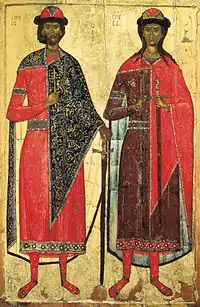
Canonization is usually divided into two categories: local and church-wide. The church-wide canonization is always performed by the highest church organ, that is the Metropolitan or Patriarch above the Council of Eparchs, the chief member above the Most Holy Synod in the synodal period, or the Patriarch of Moscow and all of Russia above the Holy Synod of the Russian Orthodox Church in contemporary Russia. The local canonization is performed in either one church or monastery, or in one eparchy, by the local episcope with the approval of the Metropolitan or Patriarch and the highest church organ, to honour one person or people who are better known in a particular region. In cases when the local canonization was performed without the blessing of the highest church organ, the previous canonization process won't be annulled but will be performed again as it should be. Sometimes the Head of the Church himself or the metropolitanate accomplishes the local canonization. Both local and church-wide canonizations are honoured the same way; they should not be expressed as higher and lower canonizations. A saint can be both local and church-wide, and in very rare cases he or she can be de-canonized. Canonization takes place under different time and reason; for example in the same day when the translation of the relics is accompanied by a wonder, or only several centuries later.
Church historians name either five or seven periods of canonization in Russia; those who state there were five periods typically merge the Nicholas II-period with the Synodal-period and the post-revolutionary with the post-Soviet era. However, the seven period-system is used here for a better understanding of the Russian canonization history. Those are the following: 1) 9th century – 1547, 2) 1547 and 1549 (Macarius Councils), 3) 1550–1721 (pre-Petrine period), 4) 1721–1894 (Synodal-period), 5) 1894–1917 (Nicholas II-period), 6) 1917–1987 (post-revolutionary period), 7) from 1988 (post-Soviet period).[1]
Early history of Christianity in the Rus' lands
Christianity came to the Slavs already in the 1st century. According to early church historians, Apostle Andrew preached Christianity to Slavs and Scythians, in the area between Eastern Europe in the west, and Caucasus and at the Black Sea coast in the south and east,[2] particularly in Scythia within the autocephalous Scythian eparchy. Other active eparchies included the Gothian, Sourozhian, Fullian and the Bosporian. In this period Christianity began to rise within this area.[3] Christianity was spread in the 9th century by crucial happenings that are often characterized as baptisms; if excluding the first baptism of the Rus under Apostle Andrew, those are the preachings and enlightenings of Slavs by Cyril and Method, the baptism of and by Askold and Dir,[4] the baptism of and by Olga[5] and finally the actual baptism under Vladimir I in 988.[6]
Hagiology
The hagiology in the first period was particularly influenced by the Greek tradition. The Russian Church was one of several metropolitanates of the Constantinople Orthodox Church (i.e. the Greek Church), and almost all of the Metropolitans were of Greek origin (exceptions include Hilarion and Kliment).[7] Following several Mongol-Tatar raids on Kiev in the mid-13th century, the cathedra was eventually moved to Vladimir in 1283[8] and to Moscow in 1325.[9]
The Russian Church became less depended by the Constantinople Orthodox Church over the years. After the Fall of Constantinople in 1453 the wish for autonomity gradually increased.[10] For example, under Jonah the Russian Church factually became autocephalous. The formation of the Russian Tsardom under Ivan IV in 1547 and Metropolitan Macarius' Menologion made way for two so-called Macarius Councils in 1547 and 1549. The first one began on 1 February 1547 and includes both local and church-wide canonizations. Information about the following 1549 Council is less detailed – it is basically based on two sources; a mention of it by Ivan IV on the Stoglavy Council and the list of canonized people from the Lives of Saints of Metropolitan Jonah. Whether those were local or church-wide canonizations is not exactly known. Altogether 39 saints were canonized on those Councils. They were ideal models for the upcoming canonizations, and had a positive influence on the church and civic society.[11]
The majority of saints were canonized in the period between 1550 and 1721, including around 123 local and 23 church-wide saints. Some were included in Synaxes (собор), groupings of saints of a region, such as Synaxis of All Saints of Novgorod or Synaxis of All Saints of Moscow. That period was marked by the happenings of the Schism of the Russian Church, caused by Patriarch Nikon's reforms, which resulted to de-canonizations (and later re-canonizations) of some saints, such as of Anna of Kashin and Maxim the Greek.[12]
Following Peter I's western-influenced church reforms and centralization of the state in 1721 the Russian Church partially lost its independence from the state. The highest church organ was now the Most Holy Synod, a type of Council of Church Affairs, featuring non-clergical officials. In that period, from 1721 to 1894, the local canonization was completely removed as the tradition of honouring relics of local saints was seen as superstitious according to the Spiritual Regulation of 1721,[13] and the church-wide canonizations greatly decreased. On the other hand, some of the most important saints were canonized in that period, such as the vast majority of Kiev Caves monks or Metropolitan Michael I.[14]
A separate period within the Synodal period were the last years of the Russian Empire, ruled by Emperor Nicholas II (1894–1917). Nicholas II re-established the local canonization, and tried to recover the pre-Petrine format. For the first time since the last local canonization two centuries ago, the tradition has been reawaken in 1900, when 222 Orthodox believers led by St. Metrophanes were martyred during the anti-Christian Boxer Rebellion by the Yihetuan. A high point was the ceremonial canonization of Seraphim of Sarov, where the Emperor personally carried the coffin and thousands of people came to that celebration from all of over Russia. Another factor in the rapid growth of canonizations was the progressed hagiological and hagiographical researches between the 2nd half of the 19th century and the early 20th century in Russia.[15] Furthermore, a future Council was expected to address questions regarding the gradual change to the traditional pre-Petrine system, but the date was always postponed until the revolutions. The church life flourished and reached records; for example, around 95,000 monks lived in Russia in 1914, while before that the number lied between 44,554 in 1894 and 25,207 in 1724.[16]
The Council from 1917 to 1918 also reviewed the practique of canonization, and can be viewed as a continuation of de-bureaucratization of the Synod. On the other side, the post-revolutionary years saw a radical secularization of the state. The new Soviet regime was even more hostile towards the Church and religion than the Russian Provisional Government. In the 1960s, when the Church strengthened inter-religious affairs, it canonized saints of other local churches, such as John the Russian and Herman of Alaska. Logically, the Russian Church overlept the myriad of martyrs died during severe Christian persecutions. Instead of local canonizations, the saints were often grouped into synaxes, to avoid conflicts with the atheist government. Between 1978 and 1979, the second and third volumes of the Reference Book of the Clergy allowed researching the pre-revolutionary hagiography.[17]
A new era in church life started from 1988, during the Millennium of the Baptism of the Rus', when another Council was opened. In the following years canonizations that were previously unimaginable in the Communist regime were now performed, most notably of New Martyrs. Important canonizations include that of Dmitry Donskoy and Patriarch Tikhon.[18]
Saint titles
A traditionally practique in the Orthodox canonization is to add saint titles before the name of the saint. In the first Christian years, those were mainly martyrs. In the late 10th century, before the Great Schism, canonization of hierarchs became possible, which made way to new saint titles, such as Enlightener and Equal-to-apostles. In the course of the years more titles were added, sometimes special titles were created after influential events (e.g. New Martyr).[19]
The following list of saints include the saint title in italics. Saint titles including Wondermaker and Holy Unmercenaries are commonly not included next to the name of the saint as such qualities are obvious for the most saints. The following titles are listed here and in the sister page:[20][21]
|
|
Chronological list
The following list includes saints from the early years until the 15th century, most of which are Russians in the most different sense, while others are essential and important people in the Russian history. The period in which the saint was canonized is listed in the Number (#) column. The Portrait column typically illustrates the saint on icons or frescos, next to it are the name of the saint and his title, repeated just below in Russian. The following column describes in abbreviated form the saint's life and legacy. Name dates are listed both in old and new style dates, following a more precise date description. The Canonization column may list both local and church-wide canonizations; the question mark means the unknown date, but definite canonization, and a simple date without the type of canonization in brackets means the doubtful type of canonization.
Rulers/Monarchs Heads of Church
| # | Portrait | Saint title (s) / Name | Short description Reason for canonization |
Name date(s) (O.S. & N.S.) |
Canonized | Ref. |
|---|---|---|---|---|---|---|
.jpg.webp) |
Apostle Andrew the First-Called (☦ 62) Святой апостол Андрей Первозванный |
Apostle Andrew preached in the Eastern lands (Caucasus, Eastern Europe) to Scythians and Slavs. Legend has it that Apostle Andrew raised a cross where the city of Kiev would one day be; patron saint of Russia and its Navy[22] | 30 November 13 December 27th Week after Pentecost Седмица 27-я по Пятидесятнице |
Natural canonization | [23] | |
| 7 | Hieromartyrs Ephraim, Basilius, Eugenius, Elpidius, Agaphodorus, Epherius and Сapiton of Chersones (4th century) Священномученики Ефрем, Василий, Евгений, Елпидий, Агафодор, Еферий и Капитон, епископы Херсонесские |
Episcopes of Chersonesus; preached in a difficult time of Christian persecutions by pagans during Diocletian's rule
Ephraim and Basilius were sent to Chersonesos to spread Christianity; Ephraim was beheaded by Scythian pagans; Basilius resumed enlightening people, but was expelled and cloistered himself into a cave, when once he made alive a person with blessed water and the people there took baptism; he was stoned to death by Jews Eugenius, Elpidius and Agaphodorus were episcopes in the Dardanelles, who moved to Chersonesus, but were martyred the same way as Basilius; Epherius moved to Chersonesus, and living in peace under Constantine's rule, built a church there Capiton was sent by Constantine to help Epherius, but on the way to Constantinople his ship was eventually looted and he was drowned by pagans |
7 March 20 March 3rd Week of the Great Lent Седмица 3-я Великого поста |
1988 (church-wide)[18] | [24] | |
| 5 | 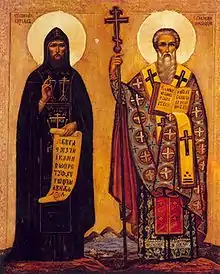 |
Equal-to-apostles, First Teachers and Slavic Enlighteners Cyrill (☦ 862) and Methodius (☦ 885) Равноапостольные первоучители и просветители славянские Кирилл и Мефодий |
Preachers of Christianity in the East; sent to teach the Slavs | Cyrill
14 February |
1909 (church-wide) 1863 (local)[15] |
[25] [26] |
| Cyrill and Methodius
11 May | ||||||
| 1 | .jpg.webp) |
Equal-to-apostles, Great Princess Olga, baptized Elena (☦ 969) Равноапостольная великая княгиня Ольга, во святом крещении Елена |
The first woman ruler of Rus' (regent); the first Christian among the Russian rulers; while she could not baptize her country, her grandson Vladimir resumed her Christianization | 11 July 24 July 7th Week after Pentecost Седмица 7-я по Пятидесятнице |
mid-13th century[19] | [27] |
 |
Protomartyrs, Theodore and John the Varyags (☦ 983) Первомученики Феодор и Иоанн Варяжские |
First known martyrs on the Rus'; Theodore baptized after raid on Byzantine; after he and his son John were chosen as sacrifices for a pagan ritual by the order of then-pagan Vladimir I, they were brutally murdered by the raving crowd after preaching Christianity | 12 July 25 July 7th Week after Pentecost Седмица 7-я по Пятидесятнице |
? | [28] | |
| 4 | .jpg.webp) |
Enlightener Metropolitan Michael I of Kiev (☦ 983) Святитель Михаил, митрополит Киевский |
1st Metropolitan of Kiev, Metropolitan of all Rus; Mikhail was a Syrian who was sent by Nicholas II of Constantinople after Baptism of the Rus; probably founded the St. Michael's Golden-Domed Monastery and the Mezhyhirya Monastery; preached Christianity and demolished pagan idols | 30 September 13 October 19th Week after Pentecost Седмица 19-я по Пятидесятнице |
(1730)[lower-alpha 1] (church-wide)[14] | [29] |
| 6 | Passion-bearer George the Hungarian (☦ 1015) Страстотерпец Георгий Угрин |
Brother of ven. Ephraim of Torzhok | 28 January 10 February Fast-free week Седмица сплошная |
1979 (church-wide) 1904 (local)[30] |
[31] | |
| 1 | Equal-to-apostles Grand Prince Vladimir the Great, baptized Basil (☦ 1015) Равноапостольный Великий князь Владимир, во святом крещении Василий |
8th Grand Prince of Kiev who turned from pagan to saint through his Baptism of the Rus' | 15 July 28 July 8th Week after Pentecost Седмица 8-я по Пятидесятнице |
after 1240 (local and church-wide)[19] | [32] | |
| 1 |  |
Right-Believing martyrs Princes Boris and Gleb, baptized Roman and David (☦ 1015) Мученики Благоверные князья Борис и Глеб, во святом крещении Роман и Давид |
Children of Vladimir the Great, the first saints canonized in the Rus', the first Russians canonized by the Constantinople Orthodox Church; killed by insidious and power-seeking Sviatopolk | 24 July 6 August 9th Week after Pentecost Седмица 9-я по Пятидесятнице |
1072[19] | [33] |
| 1 | 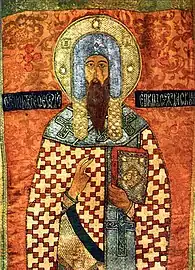 |
Enlightener Theodore, bishop of Rostov and Suzdal (☦ 1023) Святитель Феодор, епископ Ростовский и Суздальский |
First episcope of Rostov and Suzdal | 8 June 21 June 2nd Week after Pentecost Седмица 2-я по Пятидесятнице |
(1237)[34] | [35] |
| 4 |  |
Venerable Moses the Hungarian of the Caves (☦ 1043) Преподобный Моисей Угрин Киево-Печерский |
Monk in the Kiev Cave Monastery, who spent seven years as a Polish prisoner after the 1018 Kiev Expedition | 26 July 8 August 9th Week after Pentecost Седмица 9-я по Пятидесятнице |
1762 (church-wide) 1643 (local)[14] |
[36] |
| 1 | Right-Believing princess Anna of Novgorod, baptized Irina (☦ 1050) Благоверная княгиня Анна, во святом крещении Ирина, Новгородская |
Princess of Kiev and Novgorod, second wife of Yaroslav the Wise, daughter of Olaf, the first Christian king of Sweden | 10 February 23 February Meat-fare Sunday, Week of the Last Judgement Седмица мясопустная, о Страшнем суде |
1439 (local)[37] | [38] | |
| 2 | Right-Believing prince Vladimir of Novgorod (☦ 1052) Благоверный Владимир, князь Новгородский |
Prince of Novgorod, son of Yaroslav the Wise and Anna of Sweden | 4 October 17 October 19th Week after Pentecost Седмица 19-я по Пятидесятнице |
1549 (church-wide)[39] 1439 (local)[40] |
[41] | |
| 3 |  |
Venerable Ephraim of Torzhok (1053) Преподобный Ефрем Новоторжский |
A Hungarian who, having moved to Rus' with his brothers, preached Christianity and established a monastery in what is now Torzhok | 28 January 10 February Fast-free week Седмица сплошная |
1584-7 (local)[42] | [31] |
| 4 | 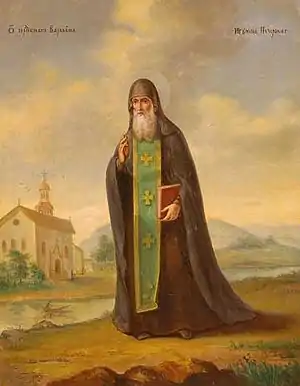 |
Venerable Barlaam of the Caves (☦ 1065) Преподобный Варлаам, Игумен Печерский |
The first abbot (hegumen) of the Kiev Caves | 19 November 2 December 26th Week after Pentecost Седмица 26-я по Пятидесятнице |
1762 (church-wide) 1643 (local)[14] |
[43] |
| 4 | 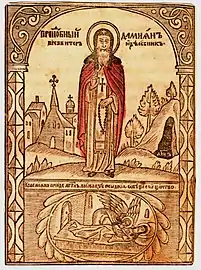 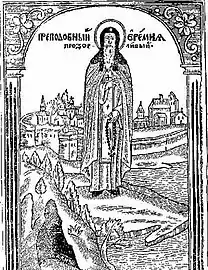 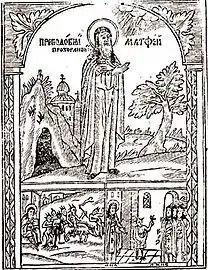 |
Venerable Damian (☦ 1071), Jeremiah (☦ 1070) and Matthew (☦ 1088) of the Caves Преподобные Дамиан, Иеремия и Матфей, Печерские |
Monks of the Caves; Damian was a healer, Jeremiah was a seer of thoughts and Matthew seer of demons | 5 October 18 October 19th Week after Pentecost Седмица 19-я по Пятидесятнице |
1762 (church-wide) 1643 (local)[14] |
[44] |
| 1 | .jpg.webp) |
Venerable Anthony of the Caves (☦ 1073) Преподобный Антоний Печерский |
Co-founder of the Caves, one of the first monasteries in Russia; the "precursor of all Russian monks" | 10 July 23 July 7th Week after Pentecost Седмица 7-я по Пятидесятнице |
1132–1231[19] | [45] |
| 1 |  |
Enlightener Leontius, bishop of Rostov (☦ 1073) Святитель Леонтий, епископ Ростовский |
Episcope of Rostov and Suzdal; missionary, the first of Kiev Caves monks who became bishop | 23 May 5 June 7th Week after Pascha Седмица 7-я по Пасхе |
early 14th century (church-wide) 1190 (local)[19] |
[46] |
 |
Right-Believing, passion bearer Yaropolk Izyaslavich, baptized Peter (☦ 1086) Благоверный Князь Ярополк, во святом крещении Петр, Волынский страстотерпец |
Prince of Volhynia and Turov, son of Iziaslav I of Kiev and Gertrude of Poland, grandchild of Yaroslav the Wise | 22 November 5 December 26th Week after Pentecost Седмица 26-я по Пятидесятнице |
late 16th century or early 17th century[47] |
[48] | |
| 4 |  |
Venerable Nikon, abbot of the Caves (☦ 1088) Преподобный Никон, Игумен Печерский |
Monk and hegumen from the Caves; captured and enslaved by nomads until miraculously released | 23 March 5 April 5th Week of the Great Lent Feast of the Annunciation (Sunday of the Akafist) Седмица 5-я Великого поста. Похвала Пресвятой Богородицы (Суббота Акафиста) |
1762 (church-wide) 1643 (local)[14] |
[49] |
| 2 | Enlightener Metropolitan John II of Kiev (☦ 1089) Святитель Иоанн, митрополит Киевский |
9th Metropolitan of Kiev, Metropolitan of all Rus | 31 August 13 September 14th Week after Pentecost Седмица 14-я по Пятидесятнице |
1547 (church-wide) 1439 (local)[50] |
[51] | |
| 4 |  |
Venerable Isaac, hermit of the Caves (☦ 1090) Преподобный Исаакий, затворник Печерский |
A hermit monk of the Caves; first Fool-for-Christ in the Rus' | 14 February 27 February Cheese-fare Week Седмица cырная (масленица) – сплошная |
1762 (church-wide) 1643 (local)[14] |
[25] |
| 1 | .jpg.webp) |
Enlightener Isaiah of Rostov (☦ 1090) Святитель Исаия, епископ Ростовский |
Second episcope of Rostov and Suzdal; missionary in Vladimir-Suzdal | 15 May 28 May 6th Week after Pascha Седмица 6-я по Пасхе |
1474 (church-wide) probably 1164 (local)[19] |
[52] |
| 4 |  |
Venerable, monkmartyr Gregory of the Caves (☦ 1093) Преподобный Григорий, Печерский чудотворец |
Monk of the Caves; "Creator of Canons"; wondermaker | 8 January 21 January 31st Week after Pentecost Седмица 31-я по Пятидесятнице |
1762 (church-wide) 1643 (local)[14] |
[53] |
| 4 | Venerable Stephen of the Caves (☦ 1094) Преподобный Стефан Печерский, Епископ Владимиро-Волынский |
Monk, pupil of Gregory of the Caves; episcope of Vladimir-Volhynia | 27 April 10 May 3rd Week after Pascha Седмица 3-я по Пасхе |
1762 (church-wide) 1643 (local)[14] |
[54] | |
| 4 |  |
Venerable Agapetus of the Caves (☦ 1095) Преподобный Агапит Печерский, Безмездный Врач |
Henoch; Unmercenary Healer; one of the first physicians in the Rus', healed Prince Vladimir Monomach | 1 June 14 June 1st Week after Pentecost (Low Week) Седмица 1-я по Пятидесятнице (сплошная) |
1762 (church-wide) 1643 (local)[14] |
[55] |
| 4 |  |
Monkmartyr Eustratius of the Caves (☦ 1097) Преподобномученик Евстратий Печерский |
Monkmartyr of the Caves | 28 March 10 April 6th Week of the Great Lent (Palm Week) Седмица 6-я Великого поста (седмица ваий) |
1762 (church-wide) 1643 (local)[14] |
[56] |
| 4 | Monkmartyrs Basil and Theodore of the Caves (☦ 1098) Преподобномученики Василий и Феодор Печерские |
Monkmartyrs of the Caves | 11 August 24 August 11th Week after Pentecost) Седмица 11-я по Пятидесятнице |
1762 (church-wide) 1643 (local)[14] |
[57] | |
| 4 | 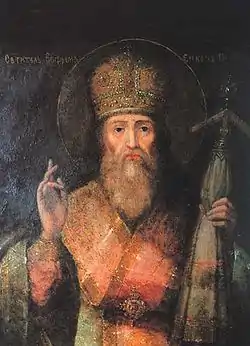 |
Venerable Ephraim of the Caves, bishop of Pereyaslavl (☦ 1098) Преподобный Ефрем Печерский, епископ Переяславский |
Episcope of Pereyaslavl | 28 January 10 February Palm Week Седмица сплошная |
1762 (church-wide) 1643 (local)[14] |
[31] |
| 3 | Venerable Arсadius of Torzhok and Vyazma (11th century) Преподобный Аркадий Новоторжский и Вяземский |
Student and cell attendant of Ephraim of Pereyaslavl | 13 December 26 December 29th Week after Pentecost Седмица 29-я по Пятидесятнице |
1594[58] | [59] | |
| 1 | 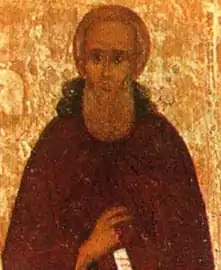 |
Venerable Abraham of Rostov (11th century) Преподобный Авраамий Ростовский |
Founder of the Abraham Epiphany Monastery in Rostov | 29 October 11 November 23rd Week after Pentecost Седмица 23-я по Пятидесятнице |
late 15th – early 16th century[60] | [61] |
| 4 | Venerable Hilarion, schema-monk of the Caves (11th century) Преподобный Иларион, схимник Печерский |
Strict ascetic, associate and student of ven. Theodosius († 1074). Prayed night and day with tears, keeping a strict fast. His contemporaries knew him as a copyist, who toiled both day and night over copying of books in the cell of ven. Theodosius. Hilarion was buried in the Far Caves. | 28 August 10 September 14th Week after Pentecost Седмица 14-я по Пятидесятнице |
1762 (church-wide) 1643 (local)[14] |
[62] | |
| 4 |  |
Venerable Prochor the Saltbusher of the Caves (☦ 1107) Преподобный Прохор Лебедник, Печерский Чудотворец |
Monk who ate only prosphora from saltbush (from which he received his name) and drank only water; wondermaker | 10 February 23 February Meat-fare Sunday, Week of the Last Judgement Неделя мясопустная, о Страшнем суде |
1762 (church-wide) 1643 (local)[14] |
[38] |
| 2 | 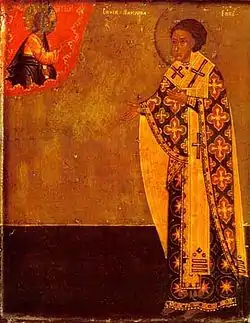 |
Enlightener Nicetas, hermit of the Caves, bishop of Novgorod (☦ 1108) Святитель Никита, затворник Печерский, епископ Новгородский |
Hermit and monk; 6th episcope of Novgorod; performed several wonders; helped building churches | 31 January 13 February Fast-free week Седмица сплошная |
1547 (church-wide)[11] | [63] |
| 4 | Venerable Pimen the Much-Ailing of the Caves (☦ 1110) Преподобный Пимен Многоболезненный, Печерский |
Hegumen; faster of the Caves | 7 August 20 August 11th Week after Pentecost Седмица 11-я по Пятидесятнице |
1762 (church-wide) 1643 (local)[14] |
[64] | |
| 4 |  |
Venerable Nestor the Chronicler of the Caves (☦ 1114) Преподобный Нестор летописец, Инок Печерский |
Henoch; chronicler, author of the Primary Chronicle (the earliest East Slavic chronicle) and several hagiographies | 27 October 9 November 22nd Week after Pentecost Седмица 22-я по Пятидесятнице |
1762 (church-wide) 1643 (local)[14] |
[65] |
| 4 |  |
Venerable Alypius the Icon Painter of the Caves (☦ 1114) Преподобный Алипий иконописец, Печерский |
Monk; one of the first Russian icon painters | 17 October 30 October 21st Week after Pentecost Седмица 21-я по Пятидесятнице |
1762 (church-wide) 1643 (local)[14] |
[66] |
| 4 | Venerable Isaiah of the Caves (☦ 1115) Преподобный Исаия, Печерский чудотворец |
Wondermaker of the Caves | 15 May 28 May 6th Week after Pascha Седмица 6-я по Пасхе |
1762 (church-wide) 1643 (local)[14] |
[52] | |
| 4 | Enlightener Amphilochius, bishop of Vladimir-Volynsky (☦ 1122) Святитель Амфилохий, епископ Владимиро-Волынский |
Henoch of Caves; later episcope of Vladimir-Volynsky; fought against superstition and pagan traditions by enlightening people | 10 October 23 October 20th Week after Pentecost Седмица 20-я по Пятидесятнице |
? (church-wide) 1866 (local)[67] |
[68] | |
| 4 | 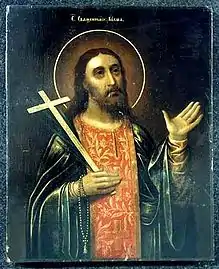 |
Venerable, hieromartyrs Kuksha and Pimen the Faster of the Caves (☦ between 1114 and 1123) Преподобные священномученик Кукша и Пимен Постник, Печерские; wondermakers |
Hieromonks; Kuksha could cast out demons, reduce rain and dry out lakes, beheaded by Vyatichi pagans; Pimen was a faster, healer | 27 August 9 September 14th Week after Pentecost Седмица 14-я по Пятидесятнице |
1762 (church-wide) 1643 (local)[14] |
[69] |
| 4 | Enlightener Theoctistus of Chernigov (☦ 1123) Святитель Феоктист, епископ Черниговский |
Hegumen of the Caves; then episcope of Chernigov; pupil of Nicetas of the Caves; spiritual father of Davyd Svyatoslavich; build churches | 5 August 18 August 14th Week after Pentecost Седмица 11-я по Пятидесятнице |
1762 (church-wide) 1643 (local)[14] |
[70] | |
| 4 | Venerable Mark the Grave Digger, John and Theophilos the Weepy of the Caves (☦ until 1125) Преподобные Марк Гробокопатель, Иоанн и Феофил Плачливый, иноки Печерского монастыря |
Henochs of the Caves | 29 December 11 January 31st Week after Pentecost, after Christmas Седмица 31-я по Пятидесятнице, по Рождестве Христовом |
1762 (church-wide) 1643 (local)[14] |
[71] | |
| 2 |  |
Venerable Prince Constantine of Murom (☦ 1129) and his sons Michael and Theodore Благоверный князь Константин и чада его Михаил и Феодор, Муромские чудотворцы |
Konstantin and his sons brought Christianity to the pagans of Murom; built churches, opened a faculty for episcopes; Michael was killed by pagans; Theodore survived and helped his father; wondermakers | 21 May 3 June 7th Week after Pascha Седмица 7-я по Пасхе |
1553 (church-wide) 1547 (local)[11] |
[72] |
| 6 | Right-Believing Grand Prince Mstislav I of Kiev, baptized Theodore (☦ 1132) Благоверный Великий князь Киевский Мстислав I, во Святом Крещении Феодор, Владимирович |
15th Grand Prince of Kiev; benevolent, devout, magnanimous | 15 April 28 April 2nd Week after Pascha Седмица 2-я по Пасхе |
1981 (church-wide)[17] | [73] | |
| 2 |  |
Right-Believing Prince Vsevolod of Pskov, baptized Gabriel (☦ 1138) Благоверный князь Всеволод, во святом крещении Гавриил, Псковский |
16th Prince of Novgorod; built churches and cathedrals, helped the poor | 11 February 24 February Cheese-fare Week Седмица сырная (масленица) – сплошная |
1549 (church-wide)[74] 1192 or 1284 (local)[11] |
[75] |
| 4 | 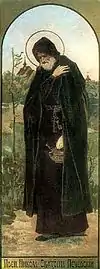 |
Venerable Nikola the Pietist, Prince of Chernigovsk, wonderworker of the Caves (☦ 1143) Преподобный Никола Святоша, князь Черниговский, Печерский чудотворец |
Prince of Chernigov, before baptism Svyatoslav, baptized Panсratius, then took the name Nikola after tonsure to monkhood; healer; known for his benevolence; wondermaker | 14 October 27 October 21st Week after Pentecost Седмица 21-я по Пятидесятнице |
1762 (church-wide) 1643 (local)[14] |
[76] |
| 1 | 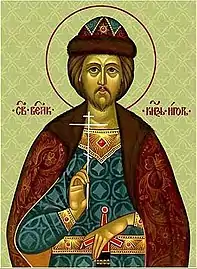 |
Blessed martyr Grand Prince Igor II of Kiev and Chernigov (☦ 1147) Блаженный Игорь, Великий Князь Черниговский и Киевский |
Grand Prince of Kiev and Chernigov, baptized Gabriel, tonsured George | General
19 September |
1549 (church-wide)[77] 1150 (local)[78] |
[79] [80] |
| Translation of the relics
5 July | ||||||
| 3 | 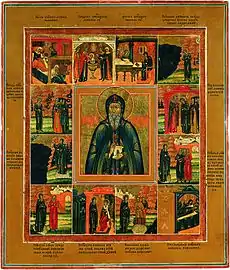 |
Venerable Anthony of Rome of Novgorod (☦ 1147) Преподобный Антоний Римлянин, Новгородский чудотворец |
Wondermaker from Rome who came to Novgorod not knowing a single word of Russian; established the Antoniev Monastery | 3 August 16 August 10th Week after Pentecost Седмица 10-я по Пятидесятнице |
1597 (church-wide)[81] | [82] |
| 4 | Venerable Onesiphorus the Perspicacious of the Caves (☦ 1147) Преподобный Онисифор Печерский, прозорливый |
Presbyter of the Caves; clairvoyant | 9 November 22 November 24th Week after Pentecost Седмица 24-я по Пятидесятнице |
1762 (church-wide) 1643 (local)[14] |
[83] | |
| 2 | Enlightener Niphont, bishop of Novgorod (☦ 1156) Святитель Нифонт, епископ Новгородский |
9th episcope of the Caves, then of Novgorod | 8 April 21 April Bright Week Светлая седмица – сплошная |
1549[11] | [84] | |
| 4 | Venerable Abraham of Mirozha (☦ 1158) Преподобный Авраамий Мирожский |
Builder and first hegumen of the Mirozhsky Monastery in Pskov | 24 September 7 October 18th Week after Pentecost Седмица 18-я по Пятидесятнице |
17th century (church-wide) (until the early 17th century) (local)[85] |
[86] | |
| 1 | Blessed enlightener Metropolitan Сonstantine I of Kiev (☦ 1159) Блаженный Константин, митрополит Киевский |
17th Metropolitan of Kiev, Metropolitan of all Rus | 5 June 18 June 2nd Week after Pentecost Седмица 2-я по Пятидесятнице |
c. 1159[87] | [88] | |
| 4 | 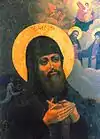 |
Venerable Erasmus of the Caves (☦ around 1160) Преподобный Еразм Печерский |
Henoch of the Caves; regretted that he did not donate his possession to the poor, and repented | 24 February 9 March 1st Week of the Great Lent. The Triumph of Orthodoxy Седмица 1-я Великого поста. Торжество Православия |
1762 (church-wide) 1643 (local)[14] |
[89] |
| 4 |  |
Venerable John the Long-suffering of the Caves (☦ around 1160) Преподобный Иоанн Многострадальный, Киево-Печерский |
Monk of the Caves; fought against his fleshly passions most of his life, once during Great Lent grabbed himself shoulder-long into the soil | 18 July 31 July 8th Week after Pentecost Седмица 8-я по Пятидесятнице |
1762 (church-wide) 1643 (local)[14] |
[90] |
| 6 | Enlightener Arcadius, bishop of Novgorod (☦ 1168) Святитель Аркадий, епископ Новгородский |
Last episcope of Novgorod; enlightened deceitful people in difficult times; prevented feuds | 18 September 1 October 17th Week after Pentecost Седмица 17-я по Пятидесятнице |
1981 (church-wide) (1439) (local)[91] |
[92] | |
| 6 | Right-Believing Grand Prince Rostislav I of Kiev and Smolensk, baptized Michael (☦ 1168) Благоверный великий князь Ростислав (во святом крещении Михаил) Киевский и Смоленский |
Prince of Smolensk, Prince of Novgorod, Grand Prince of Kiev; known for his benevolence and unselfishness | 14 March 27 March 4th Week of the Great Lent Седмица 4-я Великого поста |
1984 (church-wide)[17] | [93] | |
| 4 |  |
Venerable Arethas of the Caves (☦ 1170) Преподобный Арефа Печерский |
Hermit; became benevolent after his greed | 24 October 6 November 22nd Week after Pentecost Седмица 22-я по Пятидесятнице |
1762 (church-wide) 1643 (local)[14] |
[94] |
| 3 | Right-Believing prince Gleb of Vladimir (☦ 1173) Святой благоверный Глеб, князь Владимирский |
Prince of Vladimir, son of Andrey Bogolyubsky | 20 June 3 July 4th Week after Pentecost Седмица 4-я по Пятидесятнице |
1702 (church-wide)[95] | [96] | |
| 6 | Venerable Euphrosyne, Abbess of Polotsk (☦ 1173) Преподобная Евфросиния, игуменья Полоцкая |
At age twelve Predslava took monastic vows and became henochness; opened the Saviour-Euphrosyne Nunnery; owner of the Cross of Saint Euphrosyne; became known both throughout Russia and outside, once Byzantine king Manuel I Komnenos presented her the Icon of the Mother of God of Chersonesus, one of three written by Luke | 23 May 5 June 7th Week after Pascha Седмица 7-я по Пасхе |
1984 (church-wide)[97] | [46] | |
| 3 | 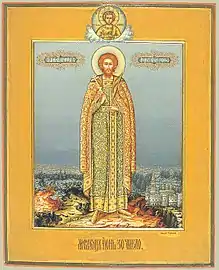 |
Right-Believing Grand Prince Andrey Bogolyubsky of Vladimir (☦ 1174) Благоверный Великий князь Андрей Боголюбский |
Prince of several principalities and Grand Prince of Vladimir; known for his piety | 4 July 17 July 6th Week after Pentecost Седмица 6-я по Пятидесятнице |
1702 (local)[95] | [98] |
| 4 |  |
Venerable Athanasius the Hermit of the Caves (☦ 1176) Преподобный Афанасий, Затворник Печерский |
Henoch, then hermit of the Caves | 2 December 15 December 28th Week after Pentecost Седмица 28-я по Пятидесятнице |
1762 (church-wide) 1643 (local)[14] |
[99] |
| 3 | Venerable Herasmus of Vologda (☦ 1178) Преподобный Герасим Вологодский |
Monk, then presbyter; established the Holy Trinity Monastery in the future city of Vologda, which, according to a legend, was founded by Herasmus | 4 March 17 March 3rd Week of the Great Lent Седмица 3-я Великого поста |
after 1691[100] | [101] | |
| 1 | Right-Believing Prince Mstislav Rostislavich the Brave of Novgorod and Smolensk, baptized Georgy (☦ 1180) Благоверный князь Мстислав, во святом крещении Георгий, Храбрый, Новгородский и Смоленский |
Prince of Belgorod, Novgorod and Smolensk; known for his devoutness and benevolence, well-doer and enlightener | 14 June 27 June 3rd Week after Pentecost Седмица 3-я по Пятидесятнице |
1549 (church-wide)[39] (after 1439) (local)[102] |
[103] | |
| 1 | 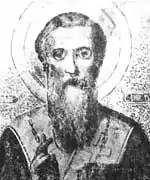 |
Enlightener Cyril, bishop of Turov (☦ 1183) Святитель Кирилл, Епископ Туровский |
5th episcope of Turov, in the last years henoch; one of the first and finest theologians and writers of the Rus', "the Russian Chrysostom" | 28 April 11 May 4th Week after Paschа Седмица 4-я по Пасхе, о расслабленом |
2nd half of 13th century – 14th century[100] | [104] |
| 4 | Venerable Polycarp of the Caves (☦ 1184) Преподобный Поликарп, Архимандрит Печерский |
Archimandrit of the Caves; spiritual adviser of Prince Rostislav Mstislavich | 24 July 6 August 9th Week after Pentecost Седмица 9-я по Пятидесятнице |
1762 (church-wide) 1643 (local)[14] |
[27] | |
| 2 | Enlightener John of Novgorod (☦ 1186) Святитель Иоанн, архиепископ Новгородский |
Eliah, then John as schema-archbishop of Novgorod; opened seven churches; was meek and affectionate | 7 September 20 September 15th Week after Pentecost. Sunday before Exaltation of the Cross Седмица 15-я по Пятидесятнице. Суббота перед Воздвижением |
1547 (church-wide) 1439 (local)[11] |
[105] | |
| 4 | 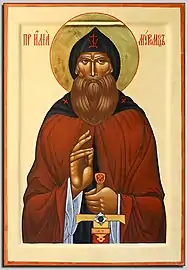 |
Venerable Ilia Muromets of the Caves (☦ 1188) Преподобный Илия Муромец, Печерский |
Henoch; travellers seeing his relics spotted on his left hand a wound perforated by a spear, and on his right hand a Sign of the Cross; thought to have been the bylina hero Ilya Muromets | 19 December 1 January 30th Week after Pentecost Седмица 30-я по Пятидесятнице |
1762 (church-wide) 1643 (local)[14] |
[106] |
| 4 | Venerable Titus of the Caves (☦ 1190) Преподобный Тит, пресвитер Печерский |
Presbyter of the Caves | 27 February 12 March 2nd Week of the Great Lent Седмица 2-я Великого поста |
1762 (church-wide) 1643 (local)[14] |
[107] | |
| 1 | 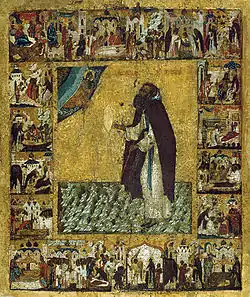 |
Venerable Barlaam of Khutyn (☦ 1192) Преподобный Варлаам Хутынский |
Hegumen; founded the Khutyn Monastery; known for his clairvoyance and wondermaking | 6 November 19 November 24th Week after Pentecost Седмица 24-я по Пятидесятнице |
(1461) (church-wide) late 13th century – 1st ½ of the 14th century (local)[19] |
[108] |
| 4 | Enlightener Laurentius, hermit of the Caves, bishop of Turov (☦ 1194) Святитель Лаврентий, затворник Печерский, епископ Туровский |
Henoch of the Caves, then hermit and episcope of Turov | 29 January 11 February Fast-free week Седмица сплошная |
1762 (church-wide) 1643 (local)[14] |
[109] | |
| 7 | Enlightener Sabbas, archbishop of Surozh (early 12th century) Святитель Савва, Архиепископ Сурожский |
Archbishop of Surozh | 2 April 12 April Holy Week Страстная седмица |
1988 (church-wide)[18] | [110] | |
| 4 | Venerable Gregory the Icon Painter, wonderworker of the Caves (11th–12th century) Преподобный Григорий иконописец, чудотворец Печерский, Сподвижник Преподобного Алипия |
Henoch; icon painter of Caves; companion of Alypius of the Caves; wondermaker | 8 August 21 August 11th Week after Pentecost Седмица 11-я по Пятидесятнице |
1762 (church-wide) 1643 (local)[14] |
[111] | |
| 6 | Venerable Alfanov brothers: Clement, Cyrill, Nicephorus, Nicetas and Isaac (11th–12th century) Преподобные братья Алфановы: Климент, Кирилл, Никифор, Никита И Исаакии |
Posadniks, builders and ktitors of the Sokolnitsky Monastery in Novgorod | 4 May 17 May 4th Week after Pascha Седмица 4-я по Пасхе |
1981 (church-wide)[17] | [112] | |
| 4 |  |
Venerable Nikon the Dry of the Caves (12th century) Преподобный Никон Сухий (Сухой), Печерский |
Henoch; captured by Cumans with Eustratius of the Caves; nicknamed 'Dry', because of the effect immense blood loss due to torture cause on his body | 11 December 24 December 29th Week after Pentecost Седмица 29-я по Пятидесятнице |
1762 (church-wide) 1643 (local)[14] |
[113] |
| 4 | Venerable Sylvester of the Caves (12th century) Преподобный Сильвестр Печерский |
Monk; resumed work on the Nestor Chronicle | 2 January 15 January 30th Week after Pentecost Седмица 30-я по Пятидесятнице |
1762 (church-wide) 1643 (local)[14] |
[114] | |
| 4 | Venerable Macarius of the Caves (12th century) Преподобный Макарий Печерский |
Faster; monk of the Caves | 19 January 1 February 32nd Week after Pentecost Седмица 32-я по Пятидесятнице |
1762 (church-wide) 1643 (local)[14] |
[115] | |
| 4 | Venerable, wonderworker Sabbas of the Caves (12th century) Преподобный Савва Печерский |
Monk of the Caves | 24 April 7 May 3rd Week after Pascha Седмица 3-я по Пасхе |
1762 (church-wide) 1643 (local)[14] |
[116] | |
| 4 | Venerable Onesimus of the Caves (12th century) Преподобный Онисим, Затворник Печерский |
Hermit of the Caves | 21 July 3 August 8th Week after Pentecost Седмица 8-я по Пятидесятнице |
1762 (church-wide) 1643 (local)[14] |
[117] | |
| 4 | Venerable Anastasius of the Caves (12th century) Преподобный Анастасий Печерский |
Deacon; monkmartyr of the Caves | 22 January 4 February |
1762 (church-wide) 1643 (local)[14] |
[118] | |
| 4 | Venerable Spyridon, Nicodemus and Anatolius of the Caves (12th century) Преподобные Спиридон и Никодим, Просфорники, и преподобный Анатолий Печерские |
Monks; host-givers (a type of minister); wondermakers | 31 October 13 November 23rd Week after Pentecost Седмица 23-я по Пятидесятнице |
1762 (church-wide) 1643 (local)[14] |
[119] | |
| 4 | Venerable Theophanes, faster of the Caves (12th century) Преподобный Феофан, постник Печерский |
Faster; monk of the Caves | 11 October 24 October 20th Week after Pentecost Седмица 20-я по Пятидесятнице |
1762 (church-wide) 1643 (local)[14] |
[120] | |
| 4 | 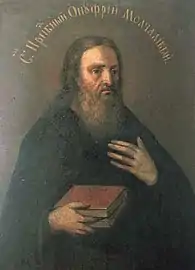 |
Venerable Onuphrius the Quiet of the Caves (12th century) Преподобный Онуфрий (Молчаливый) Печерский |
Starets; wondermaker; known for his quietness | 21 July 3 August 8th Week after Pentecost Седмица 8-я по Пятидесятнице |
1762 (church-wide) 1643 (local)[14] |
[117] |
| 6 | Enlightener John, episcope of Rostov (☦ 1213) Святитель Иоанн, епископ Ростовский |
Consecrated the Dormition Cathedral in Vladimir | 17 January 30 January 32nd Week after Pentecost Седмица 32-я по Пятидесятнице |
1982 (church-wide)[17] | [121] | |
| 2 |  |
Venerable Abraham of Smolensk (☦ 1221) Преподобный Авраамий Смоленский |
Monk and icon-painter; justified by a miracle and acquitted against the charges leveled against him | 21 August 3 September 13th Week after Pentecost Седмица 13-я по Пятидесятнице |
1549 (church-wide)[74] 1st half of the 16th century (local)[11] |
[122] |
| 6 | Venerable Anthony of Dymskoye (☦ 1224) Преподобный Антоний Дымский |
Henoch of the Khutynsk Monastery, pupil of Barlaam; refused his succession and founded the Dymsky Monastery | 24 June 7 July 5th Week after Pentecost Седмица 5-я по Пятидесятнице |
1981 (church-wide)[17] | [123] | |
| 6 |  |
Enlightener Simon, bishop of Vladimir and Suzdal (☦ 1226) Святитель Симон, епископ Владимирский и Суздальский |
Episcope of Vladimir and Suzdal, monk of the Caves, then hegumen and episcope of the Nativity Monastery of Vladimir; chronicler, author of the Kiev Caves Lavra Patericon | 10 May 23 May 5th Week after Pascha Седмица 5-я по Пасхе |
1982 (church-wide)[17] | [124] |
| 3 | 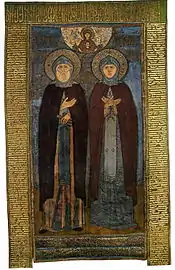 |
Right-Believing Prince Peter and Princess Fevronia of Murom (☦ 1228) Благоверные князь Петр, в иночестве Давид, и княгиня Феврония, в иночестве Евфросиния, Муромские чудотворцы |
Prince and Princess of Murom, tonsured David and Euphrosynia; saintly married couple, an ideal of the family love and fidelity; wondermakers | 25 June 8 July 5th Week after Pentecost Седмица 5-я по Пятидесятнице |
(1553) (church-wide) 1st half of the 16th century (local)[12] |
[125] |
| 1 | .jpg.webp) |
Martyr Abraham of Bulgaria (☦ 1229) Мученик Авраамий Болгарский |
Muslim-born convert from Volga Bulgaria, killed for his conversion; martyr | 1 April 14 April Holy Week Страстная седмица |
1549 (church-wide)[39] 1230 (local)[19] |
[126] |
| 4 | .jpg.webp) |
Right-Believing Prince Fyodor Yaroslavich of Novgorod (☦ 1233) Благоверный князь Феодор Новгородский |
Prince of Novgorod | 5 June 18 June 2nd Week after Pentecost Седмица 2-я по Пятидесятнице |
Sinodal-period (church-wide)[14] 1614 (local)[127] |
[88] |
| 2 | Venerable Ephraim of Smolensk (☦ 1238) Преподобный Ефрем Смоленский |
Pupil of Abraham; known for his meekness and Christian love | 21 August 3 September 13th Week after Pentecost Седмица 13-я по Пятидесятнице |
1549 (church-wide)[39] | [122] | |
| 3 | 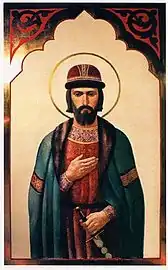 |
Martyr Mercury of Smolensk (☦ 1238) Мученик Меркурий Смоленский |
Soldier; the Mother of God appeared to him during prayer and ordered him to free his people from Batu's raiders; behead by Tatars | 24 November 7 December 26th Week after Pentecost Седмица 26-я по Пятидесятнице |
early 17th century (local)[128] | [129] |
| Right-Believing martyr Prince Basil (Vasilko) Konstantinovich of Rostov (☦ 1238) Благоверный князь мученик Василий (Василько) Ростовский |
Prince of Rostov who during Battle of the Sit River refused to convert to his enemies' religion | 4 March 17 March 3rd Week of the Great Lent Седмица 3-я Великого поста |
until 1st half of the 17th century (local)[128] | [101] | ||
| 3 | Right-Believing martyr Grand Prince George (Yuri) Vsevolodovich of Vladimir (☦ 1238) Благоверный Великий князь Георгий (Юрий) Всеволодович Владимирский |
Prince of Vladimir, who during Battle of the Sit River was martyred by Tartar Mongols | 4 February 17 February |
(1643) (church-wide)[12] | [130] | |
| 5 | Right-Believing martyr Princess Eupraxia of Pskov (☦ 1243) Благоверная княгиня мученица Евпраксия Псковская |
Princess; founded the John the Baptist Monastery and became first hegumeness; killed by her stepson; a wonder happened when from an icon above her grave scattered myron | 16 October 29 October 21st Week after Pentecost Седмица 21-я по Пятидесятнице |
1734 (church-wide) c. 1859 (local)[131] |
[132] | |
| 6 | Blessed Grand Princess Theodosia (☦ 1244) Блаженная Великая княгиня Феодосия |
Princess, daughter of Mstislav the Brave, Mother of Alexander Nevsky | 5 May 18 May 5th Week after Pascha, the Sunday of the Samaritan Woman Седмица 5-я по Пасхе, о самаряныне |
1981 (church-wide)[17] | [133] | |
| 1 |  |
Martyrs and confessors, Right-Believing Prince Michael and his boyar Theodore, of Chernigov (☦ 1246) Мученики и исповедники: благоверный князь Михаил и болярин его Феодор, Черниговские чудотворцы |
Prince of Chernigov killed by Mongol-Tatars for his adherence to the Christian faith; the same destiny faced his boyar Theodore; wondermakers | 20 September 3 October 17th Week after Pentecost Седмица 17-я по Пятидесятнице |
before the 1270s (church-wide)[19] 1246 (local)[134] |
[135] |
| 6 | Monkmartyr Eliseus of Lavrishevo (around died 1250) Преподобномученик Елисей Лавришевский |
Prince Rimund of Litovsk, baptized Lavr, or Lavrentius, then monk after persecutions by his blood-and-guts pagan father, king Traidenis; founded the Lavrishevsk Monastery | 23 October 5 November 22nd Week after Pentecost Седмица 22-я по Пятидесятнице |
1984 (church-wide) 1514 (local)[136] |
[137] | |
| 1 | Venerable Euphrosyne of Suzdal (☦ 1250) Преподобная Евфросиния Суздальская |
Theoduliya was Princess of Chernigov, elder daughter of Miсhael Vsevolodovich; after tonsure took the name Euphrosynia, then hegumeness of the Intercession Monastery, which soon became the leading nunnery in Russia | 25 September 8 October 18th Week after Pentecost Седмица 18-я по Пятидесятнице |
1st half of the 16th century[138] or (1572–81)[139] |
[140] | |
| 6 | Right-Believing Prince Svyatoslav of Yuryev, baptized Gavriil, and his son Dimitry (☦ 1253) Благоверный князь Святослав, во святом крещении Гавриил, Юрьевский и сын его Димитрий |
Svyatoslav Vsevolodovich, Grand Prince of Vladimir, Prince of other principalities, son of Vsevolod Yuryevich | 3 February 16 February Sunday of the Prodigal Son Седмица о блудном сыне |
1982 (church-wide)[17] | [141] | |
| 6 |  |
Venerable Xenophon of Robeika (☦ 1262) Преподобный Ксенофонт Робейский |
Henoch of the Khutyn Monastery, founded by Barlaam; after his death and refused succession after Anthony became third hegumen, then founded the Robeika Monastery | 28 June 11 July 5th Week after Pentecost Седмица 5-я по Пятидесятнице |
1981 (church-wide)[17] | [142] |
| 2 | 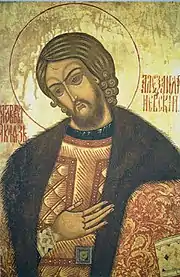 |
Right-Believing Grand Prince Alexander Nevsky (☦ 1263) Благоверный Великий Князь Александр Невский |
Prince of Novgorod and Grand Prince of Vladimir; military hero famous for the Battle of Neva and the Battle of the Ice; patron saint; known for his resistance against the Catholic West; the unification with Mongol-Tatars froze war conflicts and Russia was able to build a world power after the step by step conquers; shortly before his death took monastic vows as Aleksy; Metropolitan Cyril III after the service saw his soul being carried by an angel | 23 November 6 December 26th Week after Pentecost Седмица 26-я по Пятидесятнице |
1547 (church-wide) 1380 (local)[11] |
[143] |
| 4 | 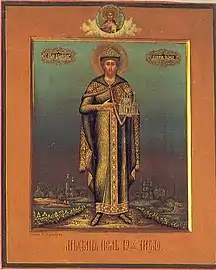 |
Right-Believing martyr Prince Roman Olgovich of Ryazan (☦ 1270) Мученик Благоверный Князь Роман (Ольгович) Рязанский |
Prince of Ryazan; tortured by Muslim Mongols after he refused to convert from his "pagan" belief to Islam, Muslims cut out his tongue and slowly other parts, then skinned his head and stuck it on a spear | 19 July 1 August 8th Week after Pentecost Седмица 8-я по Пятидесятнице |
1861 (local)[144] | [145] |
| 6 | Enlightener Serapion, bishop of Vladimir (☦ 1275) Святитель Серапион, епископ Владимирский |
Preacher and writer of the Caves; then episcope of Vladimir; fought against pagan superstition; foresaw the Wrath of God | 12 July 25 July 7th Week after Pentecost Седмица 7-я по Пятидесятнице |
1982 (church-wide)[17] | [28] | |
| 4 | Venerable Cyprian of Ustyug (☦ 1276) Преподобный Киприан Устюжский |
Landowner before tonsure to monkhood; founded the Archangel Michael Monastery | 29 September 12 October 18th Week after Pentecost Седмица 18-я по Пятидесятнице |
1841[146] | [147] | |
| 6 | Venerable Princess Charitina of Novgorod (Litovsk) (☦ 1281) Преподобная Харитина Новгородская (Литовская) |
Princess of Litovsk; then nun at the Saint Peter and Paul Nunnery in Novgorod | 5 October 18 October 19th Week after Pentecost Седмица 19-я по Пятидесятнице |
1981 (church-wide)[17] | [44] | |
| 3 |  |
Right-Believing Prince Roman of Uglich (☦ 1285) Благоверный князь Роман Угличский |
Prince of Uglich; benevolent, built towns, churches, hospitals and hospices | 3 February 16 February Sunday of the Prodigal Son Седмица о блудном сыне |
1595 or 1605 (local)[58] | [141] |
| 1 | 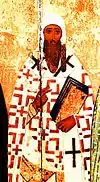 |
Enlightener Ignatius, bishop of Rostov (☦ 1288) Святитель Игнатий, епископ Ростовский |
In his early years became henoch, then episcope of Rostov; founded the Trinity Monastery in Beloozero and the Boris and Gleb Church in Rostov; enlightened pagan Finnish tribes; conciliated princes | 28 May 10 June 1st Week after Pentecost, fast-free week Седмица 1-я по Пятидесятнице, сплошная |
1474 (church-wide) (from the 14th century) (local)[19] |
[148] |
| 6 | Enlightener Simeon of Polotsk and Tver (☦ 1289) Святитель Симеон, епископ Полоцкий, епископ Тверской |
Episcope of Polotsk, then Tver; brother of Alexander Nevsky; buried Yaroslav of Tver; restored churches | 3 February 16 February Sunday of the Prodigal Son Седмица о блудном сыне |
1979 (church-wide) 1904 (local)[17] |
[141] | |
| 3 | Venerable tsarevich Peter of the Horde (☦ 1290) Преподобный Петр, Царевич Ордынский |
Tsarevich, nephew of the khan Berke; once Apostles Peter and Paul appeared in front of him and gave him building material for a new monastery | 29 June 12 July 5th Week after Pentecost Седмица 5-я по Пятидесятнице |
(1553) (church-wide)[149] | [150] | |
| 3 | 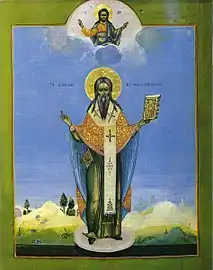 |
Enlightener Basil of Ryazan (☦ 1295) Святитель Василий, епископ Рязанский |
As episcope of Murom he helped people, but after calumny he had to fly to Ryazan, which he arrived by swimming the Oka on his cloak and using his rod as a paddle | 3 July 16 July 6th Week after Pentecost Седмица 6-я по Пятидесятнице |
1609 (local)[151] | [152] |
| 6 | Venerable Joasaph of Snetogorsk and Basil of Mirozha, of Pskov (☦ 1299) Память Псковских угодников: преподобных Иоасафа Снетогорского и Василия Мирожского и дружины их |
Hegumens who together with 27 henochs, women and children died by fire in the two monasteries, which were set on fire by Germans as a revenge of the unsuccessful raid on Pskov | 4 March 17 March 3rd Week of the Great Lent Седмица 3-я Великого поста |
1987 (church-wide)[153] | [101] | |
| 1 | Right-Believing Princes Theodore (☦ 1299) and his sons David (☦ 1321) and Constantine (14th century) of Yaroslav Благоверные князья Феодор и чада его Давид и Константин, Ярославские чудотворцы |
Prince Theodore Rostislavich the Black of Yaroslav, Mozhaisk and Smolensk was given the poor town Mozhaisk, which he significantly restored; at the time he fought alongside the Khan Mengu-Timur; opened churches on the 36 towns presented by the Khan, after the death of his elder son, Mikhail, Theodore returned to Yaroslav and built churches there, for a time ruled over Smolensk; at the end of his life was monk, and deeply repented his alliance with Mongol invaders
Constantine and David were sons of Theodore and Anna, daughter of the Khan who became his wife after the death of Thedore's previous one; wondermakers |
19 September 2 October 17th Week after Pentecost Седмица 17-я по Пятидесятнице |
1467 (church-wide or local)[154] | [79] | |
| 1 |  |
Right-Believing Prince Daumantas of Pskov, baptized Timothy (☦ 1299) Благоверный князь Довмонт, во святом крещении Тимофей, Псковский |
Prince of Pskov who made the city independent from Novgorod Republic, defender of Russia from the Livonian Order | 20 May 2 June 7th Week after Pascha Седмица 7-я по Пасхе |
1549 (church-wide)[39] 1374 (local)[155] |
[156] |
| 4 | Venerable Abraham the Laborious of the Caves (12th – 13th centuries) Преподобный Авраамий Трудолюбивый, Печерский |
Henoch of the Caves | 21 August 3 September 13th Week after Pentecost Седмица 13-я по Пятидесятнице |
1762 (church-wide) 1643 (local)[14] |
[122] | |
| 7 | Right-Believing Prince Oleg Romanovich of Bryansk (13th century) Благоверный князь Олег Брянский |
Prince of Bryansk; then founded the Peter and Paul Monastery there and became henoch | 20 September 3 October 17th Week after Pentecost Седмица 17-я по Пятидесятнице |
2003 (church-wide)[157] | [135] | |
| 3 |  |
Right-Believing Prince Vladimir and Princess Agrippina of Rzhev (13th century) Благоверный князь Владимир и благоверная княгиня Агриппина, Ржевские чудотворцы |
Wondermakers | 15 July 28 July 8th Week after Pentecost Седмица 8-я по Пятидесятнице |
late 17th century (local)[100] | [32] |
| 4 | Venerable Luke the Economist of the Caves (13th century) Преподобный Лука, Эконом Печерский |
Economist of the Caves | 6 November 19 November 24th Week after Pentecost Седмица 24-я по Пятидесятнице |
1762 (church-wide) 1643 (local)[14] |
[108] | |
| 6 | Venerable Constantine and Kosma of Kosin (of Staraya Russa) (13th century) Преподобные Константин и Косма Косинские, Старорусские |
Founded the Kosin Monastery | 29 July 11 August 10th Week after Pentecost Седмица 10-я по Пятидесятнице |
1981 (church-wide)[17] | [158] | |
| 4 | Venerable Mardarius the Hermit of the Caves (13th century) Преподобный Мардарий, затворник Печерский |
Hermit of the Caves | 13 December 26 December 29th Week after Pentecost Седмица 29-я по Пятидесятнице |
1762 (church-wide) 1643 (local)[14] |
[59] | |
| 4 | Venerable Zacharia the Faster of the Caves (13th – 14th centuries) Преподобный Захария Постник, Печерский |
Monk of the Caves | 24 March 6 April 5th Week of the Great Lent Седмица 5-я Великого поста |
1762 (church-wide) 1643 (local)[14] |
[159] | |
| 6 | Venerable Simon of Radonezh (14th century) Преподобный Симон Радонежский |
Student of Sergius of Radonezh; helped to build the Life-giving Trinity church and kellions | 10 May 23 May 5th Week after Pascha Седмица 5-я по Пасхе |
1981 (church-wide)[17] | [124] | |
| 4 | Venerable Titus of the Caves (14th century) Преподобный Тит Печерский, бывший воин |
Former soldier; after heavy head injury became henoch of the Caves | 27 February 12 March 2nd Week of the Great Lent Седмица 2-я Великого поста |
1762 (church-wide) 1643 (local)[14] |
[107] | |
| 5 | Venerable Athanasius and Theodosius of Cherepovets (14th century) Преподобные Афанасий и Феодосий Череповецкие |
Athanasius "The Iron Staff" and Theodosius were students of Sergius of Radonezh; settled at the edge of Novgorod, in Cherepovets, where they built the Holy Trinity church and founded the Resurrection Monastery | 25 September 8 October 18th Week after Pentecost Седмица 18-я по Пятидесятнице |
1841 (local)[160] | [140] | |
| 6 | Venerable Maсarius of the Pisma (14th century) Преподобный Макарий Писемский |
Student of Sergius; became hermit and cloistered himself on the River Pisma; met and became pupil of Pavel Obnorsky; founded a monastery | 10 January 23 January 31st Week after Pentecost Седмица 31-я по Пятидесятнице |
1981 (church-wide)[17] | [161] | |
| Venerable Barlaam and Gedeon of Serpukhov (14th century) Преподобные Варлаам и Гедеон Серпуховские |
Barlaam was cell-attendant of Metropolitan Aleksy, founded the Vladychny Monastery of Serpukhov; Gedeon was brother of Barlaam | 5 May 18 May 5th Week after Pascha, the Sunday of the Samaritan Woman Седмица 5-я по Пасхе, о самаряныне |
late 17th – 18th century (local)[162] | [133] | ||
| 6 | Venerable Martha of Pskov (☦ 1300) Преподобная Марфа Псковская |
Maria Dmitrievna of Pskov, granddaughter of Alexander Nevsky and daughter of his son Dmitri Aleksandrovich, wife of Daumantas; shortly before her death took the monastic vows at the John the Baptist Nunnery | 8 November 21 November 24th Week after Pentecost Седмица 24-я по Пятидесятнице |
1987 (church-wide)[17] | [163] | |
| 4 |  |
Right-Believing Prince Daniel of Moscow (☦ 1303) Благоверный князь Даниил Московский |
The first Prince of Moscow; founder of the first Moscow monasteries (Epiphany Monastery and Danilov Monastery) | 4 March 17 March 3rd Week of the Great Lent Седмица 3-я Великого поста |
18th–19th century (local)[164] | [101] |
| 2 |  |
Righteous Procopius of Ustyug (☦ 1303) Праведный Прокопий, Христа ради юродивый, Устюжский чудотворец |
Former Catholic merchant converted to Orthodoxy; prophesied the impact of the Veliky Ustyug meteorite; wondermaker | 8 July 21 July 7th Week after Pentecost Седмица 7-я по Пятидесятнице |
1547 (local)[11] | [165] |
| 6 | Enlightener Metropolitan Maximus of Kiev and Vladimir (☦ 1305) Святитель Максим, митрополит Киевский и Владимирский |
10th episcope of Vladimir, 27th Metropolitan of Kiev (Moscow cathedra), Metropolitan of all Rus Maximus ruled in a time when weak Byzantine Emperor Michael VIII established a uniate with the Catholics, resulting to conflicts and persecutions of Orthodox; after the death of predecessor Kirill III the residence was moved from Kiev to Vladimir (Suzdal), that town became subsequently capital of Russia | 6 December 19 December 28th Week after Pentecost Седмица 28-я по Пятидесятнице |
1981 (church-wide)[17] | [166] | |
| 4 | 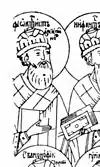 |
Enlightener Theoctistus, archbishop of Novgorod and Pskov (☦ 1310) Святитель Феоктист, архиепископ Новгородский и Псковский |
10th archbishop of Novgorod and Pskov; in late years hermit at the Annunciation Monastery | 23 December 5 January 31st Week after Pentecost Седмица 31-я по Пятидесятнице |
(1786) (local)[167] | [168] |
| 2 |  |
Right-Believing martyr Prince Michael of Tver (☦ 1318) Мученик Благоверный Князь Михаил Тверской |
Grand Prince of Vladimir and Prince of Tver; killed by Mongol-Tatars | 22 November 5 December 26th Week after Pentecost Седмица 26-я по Пятидесятнице |
1549 (church-wide)[74] (1318) (local)[11] |
[48] |
| 1 | 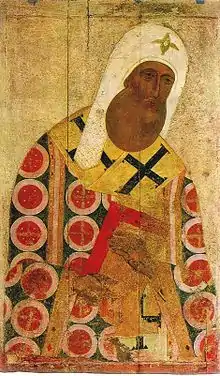 |
Enlightener Metropolitan Peter of Moscow (☦ 1326) Святитель Петр, митрополит Московский и всея России, чудотворец |
11th episcope of Vladimir, 28th Metropolitan of Kiev (Moscow cathedra), Metropolitan of all Rus; stern and talented orator who achieved some privileges for the clergy by the Horde; foresaw the rise of Moscow under Ivan I Kalita; wanted to move the cathedra to Moscow, and so the Dormition Metropolitan Cathedral was built there; wondermaker | 21 December 3 January 30th Week after Pentecost. Sunday before Christmas Седмица 30-я по Пятидесятнице. Суббота перед Рождеством Христовым |
1339 (church-wide)[169] | [170] |
| 6 | Right-Believing martyr Prince Theodore of Starodub (☦ 1330) Святой благоверный князь Феодор Стародубский |
Prince of Starodub; brutally martyred by Tatars | 21 June 4 July 4th Week after Pentecost Седмица 4-я по Пятидесятнице |
1982 (church-wide)[17] | [171] | |
| 7 | Venerable Cyrill and Maria, parents of ven. Sergius of Radonezh (☦ around 1337) Преподобные схимонах Кирилл и схимонахиня Мария, родители Преподобного Сергия Радонежского |
Schema-monks and parents of Sergius of Radonezh | 28 September 11 October 18th Week after Pentecost Седмица 18-я по Пятидесятнице |
1989[18] | [172] | |
| 3 | 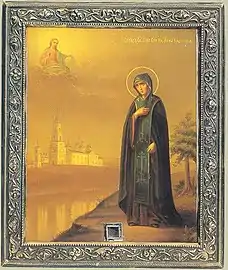 |
Venerable Anna of Kashin (☦ around 1337) Преподобная Анна Кашинская |
Princess of Tver, her ancestors include the martyrs Mikhail of Chernigov and Vasilko of Rostov, wife of Michael of Tver; was twice canonized as a holy protectress of women who suffer the loss of relatives, having lost almost all her relatives due to wars with the Golden Horde | 2 October 15 October 19th Week after Pentecost Седмица 19-я по Пятидесятнице |
1650 (church-wide)[173] 1677 (decanon.)[lower-alpha 2][12] 1908 (recanon.)[lower-alpha 3][174] |
[175] |
| 2 |  |
Martyrs Anthony, John, and Eustathius of Lithuania (Vilnius) (☦ 1347) Святые мученики Литовские (Виленские) Антоний, Иоанн и Евстафий |
Boyars executed by pagan Lithuanian Grand Duke Algirdas | 14 April 27 April 2nd Week after Pascha (Antipascha) Седмица 2-я по Пасхе (Антипасха) |
1549 (church-wide)[74] 1364 (local)[11] |
[176] |
| 6 | 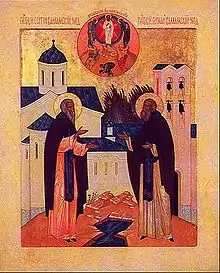 |
Venerable Sergius and Herman of Valaam (☦ around 1353) Преподобные Сергий и Герман, Валаамские Чудотворцы |
Monks who brought Christianity to Karelians and Finns; founders of the Valaam Monastery; wondermakers | 28 June 11 July 5th Week after Pentecost Седмица 5-я по Пятидесятнице |
1981 (church-wide)[17] | [142] |
| 4 | 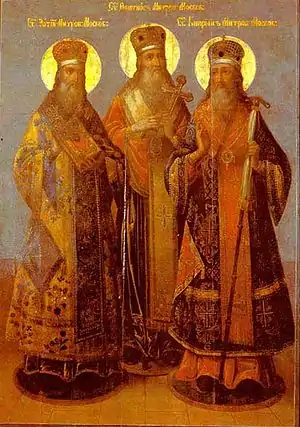 |
Enlightener Metropolitan Theognostus of Kiev and Vladimir (☦ 1353) Святитель Феогност, митрополит Киевский и Владимирский |
29th Metropolitan of Kiev (Moscow cathedra), Metropolitan of all Rus | 14 March 27 March 4th Week of the Great Lent Седмица 4-я Великого поста |
after 1805 (local)[177] | [93] |
| 3 | 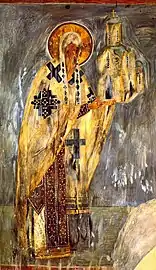 |
Enlightener Moses of Novgorod (☦ 1362) Святитель Моисей, архиепископ Новгородский |
12th archbishop of Novgorod, at early age escaped from home and took the monastic vows at the Adolescent Monastery of Tver; after recommendation of his parents moved to Yuriev Monastery of Novgorod; ruled in a difficult period of black plague, Mongol terror and robberies; made benevolencies, founded churches and monasteries, rewrote liturgical books, fought against the heresy strigolniki, enlightened pagan Novgorodians; Patriarch Philotheus I of Constantinople once presented him a cross robe which only he and his exarchates wore, and Byzantine Emperor John VI Kantakouzenos an ecclesiastical letter missive; cloistered himself at the Resurrection Wooden Monastery, but then had to return; in late years retired at the Nikolo-Skovorodian Monastery | 25 January 7 February |
until 2nd half of the 17th century (local)[178] | [179] |
| 6 | Venerable Cyrill the Czech (of Chelmogorsk) (☦ 1368) Преподобный Кирилл Чешский (Челмогорский) |
At an early age went to the Antoniev Monastery in Novgorod; then settled into a cave in Kargopol, built a chapel and kellion (chapel cell); preached Christianity to the Chuds, built for them the Epiphany Church and for the henochs a monastery | 8 December 21 December 28th Week after Pentecost Седмица 28-я по Пятидесятнице |
1981 (church-wide)[17] | [180] | |
| Enlightener John of Suzdal (☦ 1373) Святитель Иоанн, епископ Суздальский |
2nd episcope of Suzdal; benevolent, built a hospital, enlightened pagan Mordvins | 15 October 28 October 21st Week after Pentecost Седмица 21-я по Пятидесятнице |
mid-16th century (local)[181] | [182] | ||
| 3 | Venerable Abraham of Galich and Chukhloma (☦ 1375) Преподобный Авраамий Галичский, или Чухломский |
Student of Sergius; known for his meekness; after becoming hieromonk moved to Kostroma, at the border of the towns Galich and Chukhloma, and opened some monasteries; enlightened baptized, but amoral and superstitious, people; built a kellion after hearing a voice which gave him the Mother of God icon of Galich; founded a skete and then the Dormition Monastery; after rising community, built the Deposition of the Virgin's Girdle Church; founded another two cloisters after searching for a better place to live reclusively, the Synaxis Monastery and the Intercession Monastery | 20 July 2 August 8th Week after Pentecost Седмица 8-я по Пятидесятнице |
(1553), 1621 (church-wide)[183] | [184] | |
| 1 | .jpg.webp) |
Enlightener Metropolitan Alexius (☦ 1378) Святитель Алексий, митрополит Московский и всея России, чудотворец |
4th episcope of Suzdal, 30th Metropolitan of Kiev (Moscow cathedra), Metropolitan of all Rus; boyar Fyodor Byakont after a dream was tonsured at the Epiphany Monastery in Moscow, met there Stephen, elder brother of Sergius of Radonezh; regent during Prince Dmitry Donskoy's minority; spiritual tutor of Dmitry Donskoy and Vladimir the Bold; saved the country from a Tatar raid by miraculous curing of Taydulla, wife of Khan Jani Beg of the Golden Horde; wondermaker | 12 February 25 February Cheese-fare Week Седмица cырная (масленица) – сплошная |
late Dec. 1448 (church-wide) (1431) (local)[19] |
[185] |
| 6 | Venerable Theodoria of Nizhny Novgorod (☦ 1378) Преподобная Феодора, в миру Анастасия (Васса), Нижегородская |
Anastasia (Vassa), daughter of a Tverian boyar; since her early years wished to become a nun, so after the death of her rich husband freed serfs, gave her property to the church and the poor, and took the vows at a nunnery in Galich | 16 April 29 April 2nd Week after Pascha. Day of Rejoicing. Commemoration of the Departed Седмица 2-я по Пасхе. Радоница. Поминовение усопших |
1982 (church-wide)[17] | [186] | |
| 3 | 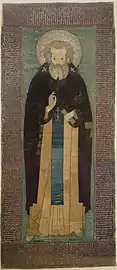 |
Venerable Silvester of the Obnora (☦ 1379) Преподобный Сильвестр Обнорский |
Student of Sergius of Radonezh; recluse on the banks of the Obnora River to whom people came after a visit of a man; moved to Moscow and was given antimension and blessing for the future monastery and church | 25 April 8 May 3rd Week after Pascha Седмица 3-я по Пасхе |
until 2nd half of the 16th century (local)[178] | [187] |
| 6 | Venerable Pachomius of Nerekhta (☦ 1384) Преподобный Пахомий Нерехтский |
Jakob Ignatyev took the monastic vows at the Nativity Monastery; became hegumen as Pachomius at the restored Tsar Konstantin Monastery outside Vladimir; then founded a new monastery in Nerekhta, near Kostroma; once during blessing of the water cured a man suffering drinking bout; several wonders happened after his death | 15 May 28 May 6th Week after Pascha Седмица 6-я по Пасхе |
1981 (church-wide)[17] | [52] | |
| 3 | 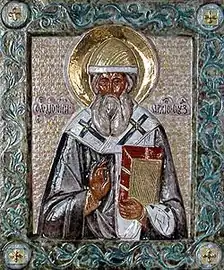 |
Enlightener Metropolitan Dionysius I (☦ 1385) Святитель Дионисии, архиепископ Суздальский |
Archbishop of Suzdal, 34th Metropolitan of Kiev (Moscow cathedra), Metropolitan of all Rus; in his early years lived in a cave at a high coast of the River Wolga, outside Nizhny Novgorod; later founded the Ascension Monastery; fought against the heretic sect Strigolniki and defeated it in Pskov with the power of his words; after his return from Constantinople was detained by Vladimir Olgerdovich in Kiev, where he died | 26 June 9 July 5th Week after Pentecost Седмица 5-я по Пятидесятнице |
1621 (church-wide)[188] | [189] |
| 6 | Venerable Micah of Radonezh (☦ 1385) Преподобный Михей Радонежский |
One of the first teachers and cell-attendants of Sergius of Radonezh; known for his meekness | 9 May 22 May 5th Week after Pascha Седмица 5-я по Пасхе |
1981 (church-wide)[17] | [190] | |
| 7 | Right-Believing Grand Prince Dmitry Donskoy (☦ 1389) Благоверный Великий Князь Димитрий Донской |
Prince of Moscow, Grand Prince of Vladimir; war hero; the first Prince of Moscow to openly challenge Mongol authority in Russia, famous for the Battle of Kulikovo | 19 May 1 June 7th Week after Pascha, Sunday of the Holy Fathers Седмица 7-я по Пасхе, святых отцев I Вселенского Собора |
1988 (church-wide)[18] | [191] | |
| 3 | Venerable Methodius of the Peshnosha (☦ 1392) Преподобный Мефодий, игумен Пешношский |
Student of Sergius of Radonezh; cloistered himself into an oak forest, where he built a kellion on the fens, then a monastery, and became hegumen; known for his benevolence | 4 June 17 June 2nd Week after Pentecost Седмица 2-я по Пятидесятнице |
late 17th century – early 18th century (local)[192] | [193] | |
| 1 | 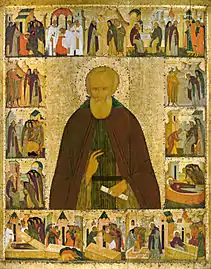 |
Venerable Demetrius of Priluki (☦ 1392) Преподобный Димитрий Прилуцкий, Вологодский |
Son of a rich merchant, tonsured in his early years at a monastery; companion of Sergius of Radonezh; founded the St. Nicholas Monastery in Pereslavl and the Spaso-Prilutsky Monastery in place Priluki (now suburb of Vologda); known for his benevolence | 11 February 24 February Cheese-fare Week Седмица cырная (масленица) – сплошная |
late 15th century (church-wide) (from 1409) (local) |
[75] |
| 1 | 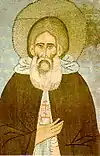 |
Venerable Sergius of Radonezh, all of Russia wondermaker (☦ 1392) Преподобный Сергий, игумен Радонежский, всея России чудотворец |
Bartholomew, son of boyars; patron saint of Russia, spiritual and monastic reformer; became hermit and built the Holy Trinity Church amidst wood in Makovets; ate only prosphora, most of it gave to bears; gradually more henochs came to him, and so the Trinity Lavra of St. Sergius was founded, the "Heart of Russia"; blessed Dmitry Donskoy for the Battle of Kulikovo; made numerous wonders; "Unifier of Russian earth"; one of the most important Russian saints, influenced the political and religious life of Russia; numerous of his later canonized students built hundreds of monasteries and churches[194][195] | 25 September 8 October 18th Week after Pentecost Седмица 18-я по Пятидесятнице |
until 1448 (church-wide) (1422) (local) |
[140] |
| 2 | 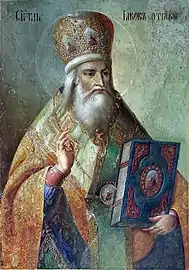 |
Enlightener Jakob of Rostov (☦ 1392) Святитель Иаков, Епископ Ростовский |
Episcope of Rostov; known for his erudition and elocution, fought against Marcian's heretic iconoclasm; saved a woman from execution, which resulted him being expelled from Rostov; swam on his mantia a river until the coasts and founded the Conception Church and the Spaso-Yakovlevsky Monastery | 27 November 10 December 27th Week after Pentecost Седмица 27-я по Пятидесятнице |
1549 (church-wide) 1st half of the 16th century (local)[11] |
[196] |
| 6 | Blessed Theodore of Novgorod (☦ 1392) Блаженный Феодор Новгородский, Христа ради юродивый |
Son of a rich family; despite his later poverty, helped the poor and blessed his insulters; Fool for Christ | 19 January 1 February 32nd Week after Pentecost Седмица 32-я по Пятидесятнице |
1981 (church-wide)[17] | [115] | |
| 6 |  |
Venerable Roman of Kirzhach (☦ 1392) Преподобный Роман Киржачский |
Student of Sergius of Radonezh; founded the monastery in Kirzhach | 29 July 11 August 10th Week after Pentecost Седмица 10-я по Пятидесятнице |
1982 (church-wide)[197] | [158] |
| 3 | Venerable Cassian and Gregory of Avnega (☦ 1392) Преподобные Кассиан и Григорий Авнежские |
Students of Sergius of Radonezh; founded a monastery in Avnega; both were killed by Tatars and the monastery was looted and destroyed | 15 June 28 June 3rd Week after Pentecost Седмица 3-я по Пятидесятнице |
1560-1 (church-wide)[198] | [199] | |
| 2 | Blessed Nicholas Kochanov of Novgorod (☦ 1392) Блаженный Николай Кочанов, Христа ради юродивый, Новгородский чудотворец |
Former rich person turned Fool-for-Christ, wondermaker | 15 June 28 June 3rd Week after Pentecost Седмица 3-я по Пятидесятнице |
1549 (church-wide)[39] |
[199] | |
| 7 | Venerable Athanasius (the younger) of Vysotsky (☦ 1395) Преподобный Афанасий (младший), игумен Высоцкий |
Hegumen of the Vysotsky Monastery, founded by Athanasius the older | 12 September 25 September 16th Week after Pentecost Седмица 16-я по Пятидесятнице |
2004 (church-wide) c. 1697 (local)[200] |
[201] | |
| 6 | Venerable Andronicus of Moscow (☦ 1395/1373) Преподобный Андроник Московский |
First hegumen of the Andronikov Monastery; in last years hermit | 13 June 26 June 3rd Week after Pentecost Седмица 3-я по Пятидесятнице |
1981 (church-wide) (late 15th century) (local)[202] |
[203] | |
| 2 | 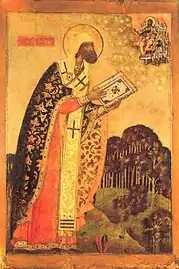 |
Enlightener Theodore III of Rostov (☦ 1395) Святитель Феодор, архиепископ Ростовский |
Archbishop of Rostov; student of Sergius of Radonezh; founder and first hegumen of the Simonov Monastery | 28 November 11 December 27th Week after Pentecost Седмица 27-я по Пятидесятнице |
1549 (church-wide)[39] |
[204] |
| 2 | 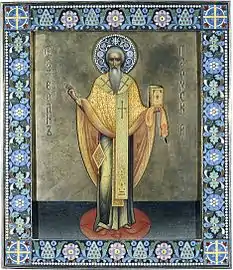 |
Enlightener Stephen of Perm (☦ 1396) Святитель Стефан, Епископ Великопермский |
Missionary, credited with the conversion of the Komi Permyaks to Christianity and the invention of Old Permic script | 26 April 9 May 3rd Week after Pascha Седмица 3-я по Пасхе |
1549 (church-wide)[74] around 1475 (local)[205] |
[206] |
| 3 | Right-Believing Prince Andrew of Smolensk, wondermaker of Pereslavl (☦ 1398) Святой Благоверный князь Андрей Смоленский, Переяславский чудотворец |
Prince of Smolensk; sexton of the St. Nicholas Church; made several wonders | 27 October 9 November 22nd Week after Pentecost Седмица 22-я по Пятидесятнице |
c. 1539[207] | [65] | |
| 6 | Venerable Lazarus and Athanasius of Murmansk (Murom) (14th – 15th centuries) Преподобные Лазарь и Афанасий Мурманские (Муромские) |
Lazarus was Greek from Constantinople; student of Athanasius and archbishop Basil; came to Novgorod, after the latter's death moved to Murmansk near Lake Onega; preached Christianity to the pagan Sami; after healing a chieftain's son, people began to convert to Christianity; founded a monastery | 8 March 21 March 3rd Week of the Great Lent Седмица 3-я Великого поста |
1974 and 1981 (church-wide)[208] | [209] | |
| 7 |  |
Venerable Andrew Rublyov the Icon Writer (15th century) Преподобный Андрей Рублев, иконописец |
Icon writer; student of Sergius of Radonezh; wrote icons on walls of churches and cathedrals such as the Dormition Cathedral of Vladimir, the Cathedral of the Annunciation of Moscow and the Trinity Monastery; author of the Mother of God icon of Vladimir for the Dormition Cathedral in Vladimir, Trinity icon for the Trinity Monastery and The Saviour icon, among others | 4 July 17 July 6th Week after Pentecost Седмица 6-я по Пятидесятнице |
1988 (church-wide)[210] | [98] |
| 6 | Blessed George of Shenkursk (15th century) Блаженный Георгий, Христа Ради Юродивый, Шенкурский Чудотворец |
Fool for Christ, wondermaker of Shenkrusk by the Vaga River | 26 April 9 May 3rd Week after Pascha Седмица 3-я по Пасхе |
1981 (church-wide)[211] | [206] | |
| 4 | 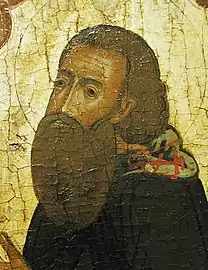 |
Venerable Amphilochius and Tarasios of the River Glushitsa (15th century) Преподобные Амфилохий и Тарасий Глушицкие |
Henochs and hegumens; students of Dionysius; preached Christianity to the pagans of Perm | 12 October 25 October 20th Week after Pentecost Седмица 20-я по Пятидесятнице |
(1621) (local)[212] | [213] |
| 3 | Venerable Jakob Bryleyevsky (15th century) Преподобный Иаков Брылеевский |
Student of Jakob of the Iron Pinery, toiler and novice of the Iron Pinery Monastery; founded the Bryleyevsky Monastery | 11 April 24 April Bright Week Светлая седмица – сплошная |
1981 (church-wide) c. 1628 (local)[214] |
[215] | |
| Venerable John of Galich (15th century) Преподобный Иоанн Галичский |
Hermit of the Paisiyev and Nikolayev Monastery | 29 May 11 June 1st Week after Pentecost, fast-free week Седмица 1-я по Пятидесятнице (сплошная) |
? | [216] | ||
| 6 | Venerable Ignatius of Spaso-Eleasarovsky (15th century) Преподобный Игнатий, Игумен Спасо-Елеазаровский |
Presbyter and first hegumen of the Spaso-Eleazarovsky Monastery | 15 May 28 May 6th Week after Pascha Седмица 6-я по Пасхе |
1987 (church-wide)[17] | [52] | |
| 6 | Venerable Mark, Jonah and Vassa of the Pskov Caves (15th century) Преподобные Марк, Иона и Васса Псково-Печерские |
Monks of the Pskov-Caves Monastery | 29 March 11 April 6th Week of the Great Lent (Palm Week) Седмица 6-я Великого поста (седмица ваий) |
1987 and 1996 (local)[217] | [218] | |
| 6 | Venerable Theodore and Paul of Rostov (15th century) Преподобные Феодор и Павел Ростовские |
1st and 2nd hegumens of the Boris and Gleb Monastery, respectively; Theodore at late years founded the St. Nicholas Monastery | 22 October 4 November 22nd Week after Pentecost Седмица 22-я по Пятидесятнице |
1964 (church-wide)[219] | [220] | |
| 4 | Blessed Basilius of Vologda (of Kubenskoye) (15th century) Блаженный Василий Вологодский, Кубенский |
Henoch of the Kamenny Monastery, near Lake Kubenskoye | 2 August 15 August 10th Week after Pentecost Седмица 10-я по Пятидесятнице |
1841[146] | [221] | |
| Venerable Nicephorus of Kaluga (15th century) Преподобный Никифор Калужский |
Student of Tikhon of Medyn | 16 June 29 June 3rd Week after Pentecost Седмица 3-я по Пятидесятнице |
? | [222] | ||
| 6 | Venerable Moses of Beloozero (15th century) Преподобный Моисей Белоезерский |
Henoch of the Kirillo-Belozersky Monastery; fortuneteller | 23 February 8 March 1st Week of the Great Lent Седмица 1-я Великого поста |
1981 (church-wide)[17] | [223] | |
| 5 | Venerable Abraham and Coprius of the River Pechenga (15th century) Преподобные Авраамий и Коприй Печенгские |
Henochs of the Kirillo-Belozersky Monastery | 4 February 17 February |
1841[lower-alpha 4] (church-wide)[224] | [130] | |
| 6 | Venerable Cornelis and Abraham of Paleostrov (15th century) Преподобные Корнилий и Авраамий Палеостровские |
Cornelis was henoch of the Valaam Monastery; preached Christianity to the pagans by the White Sea; built a church on the island Paley within Lake Onega; in late years hegumen and hermit; Abraham was his student | 19 May 1 June 7th Week after Pascha, Sunday of the Holy Fathers Седмица 7-я по Пасхе, святых отцев I Вселенского Собора |
1974,[lower-alpha 5] 1981[lower-alpha 6] (local)[225] | [191] | |
| 4 | Venerable Eleazar, Nazarius and Eumenius of Olonets (15th century) Преподобные Елеазар, Назарий и Евмений Олонецкие |
Probably Greeks from Constantinople; probably students of Lazarius of Murmansk; founded the John the Baptist Monastery near Olonets | 4 June 17 June 2nd Week after Pentecost Седмица 2-я по Пятидесятнице |
1831 (local)[226] | [193] | |
| 4 | Venerable Barsanuphius, Sabbas, Sabbatius and Euphrosyne of Tver (15th century) Преподобные Тверские: Варсонофий, Савва, Савватий и Евфросин |
Monks of the Savvin Monastery, near Tver; Euphrosyne healed Maria of Tver, wife of Grand Prince Ivan III of Moscow | 2 March 15 March 2nd Week of the Great Lent. Commemoration of the Departed Седмица 2-я Великого поста. Поминовение усопших |
1849 (church-wide) 1778 (local)[14][lower-alpha 7] |
[227] | |
| 6 | Venerable Athanasius (the older) of Vysotsky (☦ around 1401) Преподобный Афанасий (Старший), Игумен Высоцкий |
Son of a Novgorodian cleric; student of Sergius of Radonezh; cook of a monastery, then writer; per the recommendation of Vladimir the Brave, founded the Vysotsky Monastery and became hegumen there; when his namesake became his successor, went to the Constantinople Monastery, while resuming work and helping at the Vysotsky Monastery, such as directing henochs to that monastery | 12 September 25 September 16th Week after Pentecost Седмица 16-я по Пятидесятнице |
1981 (church-wide)[228] | [201] | |
| 6 | Venerable Cyriacus of Kargopol (☦ 1402) Преподобный Кириак Каргопольский |
Founded the Dormition Monastery by the Olonki River in Kargopol | 28 April 11 May 4th Week after Paschа Седмица 4-я по Пасхе, о расслабленом |
1972 (church-wide)[17] | [104] | |
| 2 | 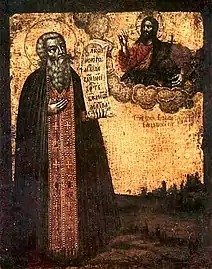 |
Venerable Euthymius of Suzdal (☦ 1404) Преподобный Евфимий, архимандрит Суздальский |
Ascetic; took monastic vows at the Pechersky Ascension Monastery by Dionysius, then Metropolitan of Moscow; founded the Monastery of St. Euthymius and became archimandrite there; companion of Sergius of Radonezh | 1 April 14 April Holy Week Страстная седмица |
1549 (church-wide)[74] 1st half of the 16th century (local)[11] |
[126] |
| 1 | Right-Believing martyrness Juliana of Vyazma, wonderworker of Torzhok (☦ 1406) Мученица благоверная княгиня Иулиания Вяземская, Новоторжская чудотворица |
Wife of Simeon, Prince of Vyazemsk; he and Juliana were murdered by Yuri, Prince of Smolensk, during a banquet; after escaping and returning, he repented for his sins; wonders happened near her grave | 21 December 3 January 30th Week after Pentecost. Sunday before Christmas Седмица 30-я по Пятидесятнице. Суббота перед Рождеством Христовым |
1407 (local)[229] | [170] | |
| 1 | .jpg.webp) |
Enlightener Metropolitan Cyprian, wondermaker of all Russia (☦ 1406) Святитель Киприан, митрополит Московский, всея России чудотворец |
31st Metropolitan of Kiev (cathedra based in Moscow), Metropolitan of all Rus; united the churches of the Grand Duchy of Moscow and Grand Duchy of Lithuania for a period; when Tamerlan rode towards the River Don, Cyprian sent his clerics from Vladimir to Moscow with the Icon of the Mother of God of Vladimir, and Tamerlan capitulated; founded the Sretensky Monastery; writer of liturgical and historical books, Lives of Saints; stored canonical works | 16 September 29 September 17th Week after Pentecost Седмица 17-я по Пятидесятнице |
1549 (church-wide)[39] 1st half of the 16th century[138] or after 1805 (local)[177] |
[230] |
| 3 | 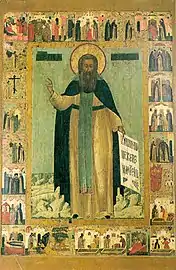 |
Venerable Stephen of Makhra (☦ 1406) Преподобный Стефан Махрищский |
Student of Sergius of Radonezh; moved for a time to Vologda and founded there a monastery, but returned; ascetic, wore rags | 14 July 27 July Commemoration of the Holy Fathers of Seven Ecumenical Councils Память святых отцев шести Вселенских Соборов |
1525-7 (church-wide)[231] | [232] |
| 2 | 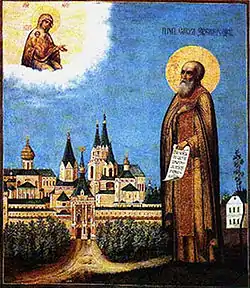 |
Venerable Sabbas of Storozhi (of Zvenigorod) (☦ 1407) Преподобный Савва Сторожевский, или Звенигородский |
One of the first students of Sergius of Radonezh; hegumen of the soon-to-be lavra; after persuasion of Prince Yuri of Zvenigorod moved near his town and founded the Savvino-Storozhevsky Monastery on Mount Storozhy and built a Nativity Church and a kellion; clairvoyanced a well; made several wonders | 3 December 16 December 28th Week after Pentecost Седмица 28-я по Пятидесятнице |
1547 (church-wide)[11] | [233] |
| 4 |  |
Venerable Grand Princess Euphrosyne of Moscow (☦ 1407) Преподобная Евфросиния, в миру Евдокия, Великая Княгиня Московская |
Grand Princess Eudoxia of Moscow, tonsured Euphrosyne; after the death of Dmitry Donskoy built in his palace the Ascension Convent; most of her life lived a luxurious, yet ascetic double life, shortly before her death took the monastic vows | 17 May 30 May 6th Week after Pascha Седмица 6-я по Пасхе |
c. 1869 (church-wide)[234] | [235] |
| 2 | .jpg.webp) |
Enlightener Arsenius of Tver (☦ 1409) Святитель Арсений, епископ Тверской |
Episcope of Tver; born to a rich family, after their death gave the estate to the poor, freed his serfs; went to the Kiev Caves; known for his deep silence and his virtue, wondermaking, healing; became archdeacon of Metropolitan Cyprian, then episcope of Tver; founded the Zhyoltikov Monastery | 2 March 15 March 2nd Week of the Great Lent. Commemoration of the Departed Седмица 2-я Великого поста. Поминовение усопших |
(1665) (church-wide)[12] 1547 (local)[11] | [227] |
| 6 | Venerable Sabbas of Moscow (☦ 1410) Преподобный Савва Московский |
Successor of Andronikos of Moscow | 13 June 26 June 3rd Week after Pentecost Седмица 3-я по Пятидесятнице |
1981 (church-wide)[17] | [203] | |
| 6 | Venerable Theophilos and Jakob of the River Omuchi (☦ 1412) Преподобные Феофил и Иаков Омучские |
Henochs; founded the Theophilos Dormition Monastery, Theophilos was hegumen, Jakob builder | 21 October 3 November 22nd Week after Pentecost Седмица 22-я по Пятидесятнице |
1981 (church-wide)[17] | [236] | |
| 3 | Venerable Sergius of the River Nurma (☦ 1412) Преподобный Сергий Нуромский |
Greek monk from Mount Athos moving to Russia; student of Sergius of Radonezh; founded the Nurma Monastery by the River Nurma | 7 October 20 October 20th Week after Pentecost Седмица 20-я по Пятидесятнице |
c. 1585 (local)[237] | [238] | |
| 6 | Enlightener Dionysius of Rostov (☦ 1425) Святитель Дионисий, архиепископ Ростовский |
Slav from Mount Athos; archimandrit of the Kamenny Monastery, then archbishop of Rostov; after cross procession through Rostov defeated plague | 18 October 31 October 21st Week after Pentecost Седмица 21-я по Пятидесятнице |
1964 (church-wide) 2nd half of the 15th century (local)[239] |
[240] | |
| 2 | 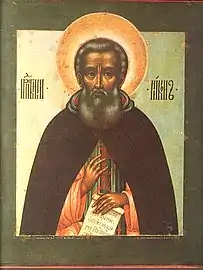 |
Venerable wondermaker Nikon of Radonezh (☦ 1426) Преподобный Никон, Игумен Радонежский, чудотворец |
Student of Sergius of Radonezh; was sent to the Vysotsky Monastery in Vysotsky; then moved back to Radonezh and after Sergius' death became hegumen; restored the monastery after Edigu's invasion; laid the first stone of the Trinity Cathedral; invited icon-writers Andrey Rublev and Daniel Chorny | 17 November 30 November 25th Week after Pentecost Седмица 25-я по Пятидесятнице |
1547 (church-wide) mid-15th – early 16th century (local)[11] |
[241] |
| 3 | 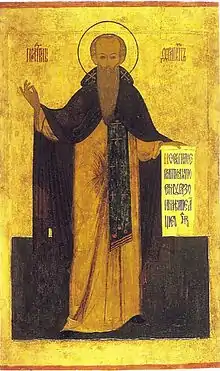 |
Venerable Therapont of Beloozero (☦ 1426) Преподобный Ферапонт Белоезерский |
At early years went to the Moscow Simonov Monastery; went to Beloozero and founded a kellion and the Nativity Monastery; near Mozhaisk founded the Ferapontov Monastery | 27 May 9 June 1st Week after Pentecost. Fast-free week Седмица 1-я по Пятидесятнице (сплошная) |
(1553) (church-wide)[242] | [243] |
| 1 | Venerable Cyril of Beloozero (☦ 1427) Преподобный Кирилл, игумен Белоезерский (Белозерский) |
Kosma; hegumen of Beloozero; went to the Simonov Monastery and took the monastic name Cyril, became cook; for a short time archimandrit and the successor of Theodore, then returned to the Simonov Monastery; founded the Kirillo-Belozersky Monastery | 9 June 22 June 2nd Week after Pentecost. All Russian Saints Day Седмица 2-я по Пятидесятнице, Всех святых в земле Российской просиявших |
until 1448 (church-wide)[19] | [244] | |
| 2 |  |
Venerable Paul of Komel (Obnora) (☦ 1429) Преподобный Павел Комельский или Обнорский |
Student of Sergius of Radonezh; took monastic vows at the Nativity Monastery on the Wolga, then moved to the Trinity Monastery; after searching a place for isolation finally stayed by the River Nurma, where he built a kellion; built the Pavlo-Obnorsky Church | 10 January 23 January 31st Week after Pentecost Седмица 31-я по Пятидесятнице |
1547 (church-wide) 1st half of the 16th century (local)[11] |
[161] |
| 6 | Hieromartyr Patricius of Vladimir (☦ 1430/1411) Священномученик Патрикий Владимирский |
Greek ecclesiarch of the Vladimir Cathedral; martyred by Tatars | 3 July 16 July 6th Week after Pentecost Седмица 6-я по Пятидесятнице |
1982 (church-wide)[17] | [152] | |
| 4 |  |
Enlightener Metropolitan Photius (☦ 1431) Святитель Фотий Московский, митрополит Киевский и Владимирский |
35th Metropolitan of Kiev (cathedra based in Moscow), Metropolitan of all Rus; assisted people in difficult times of Tatar terror | 2 July 15 July 6th Week after Pentecost Седмица 6-я по Пятидесятнице |
1805[177] | [245] |
| 3 | Blessed Maxim of Moscow (☦ 1431) Блаженный Максим, Христа ради юродивый, Московский чудотворец |
Fool for Christ, wondermaker of Moscow | 11 November 24 November 26th Week after Pentecost Седмица 26-я по Пятидесятнице |
(1568) (church-wide) 1547 (local)[12] |
[246] | |
| 2 | 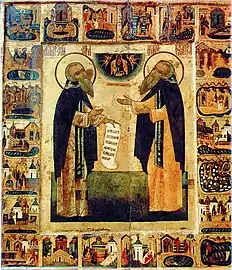 |
Venerable Sabbatius of Solovki (☦ 1435) Преподобный Савватий Соловецкий |
Monk of the Kirillo-Belozersky Monastery, then of Valaam Monastery; with Herman of Solovki founded the Solovetsky Monastery | 27 September 10 October 18th Week after Pentecost Седмица 18-я по Пятидесятнице |
1547 (church-wide) around 1503 (local)[11] |
[247] |
| 6 | Venerable Euthymius, enlightener of Karelia, and righteous Anthony and Felix (☦ 1435) Преподобный Евфимий, просветитель Карелии, и праведные Антоний и Феликс, местно чтимые |
Euthymius founded the St. Nicholas Monastery; Anthony and Felix were righteous and devout posadniks of Novgorod | 18 April 1 May 2nd Week after Pascha Седмица 2-я по Пасхе |
c. 1980,[lower-alpha 8] c. 1990[lower-alpha 9] (church-wide) 2003,[lower-alpha 10] 2004[lower-alpha 11][248] (local) |
[249] | |
| 2 |  |
Venerable Dionysius of the River Glushitsa (☦ 1437) Преподобный Дионисий, игумен Глушицкий |
Hegumen; founded five monasteries and one nunnery by the Glushitsa River, built the Intercession Church; icon-writer | 1 June 14 June 1st Week after Pentecost (Low Week) Седмица 1-я по Пятидесятнице (сплошная) |
1547 (church-wide) 1st half of the 16th century (local)[11] |
[55] |
| 3 | Venerable Alexander of the River Kushta (☦ 1439) Преподобный Александр, игумен Куштский |
Hegumen of the Kamenny Monastery; eventually cloistered himself by the Kushta River | 9 June 22 June 2nd Week after Pentecost. All Russian Saints Day Седмица 2-я по Пятидесятнице, Всех святых в земле Российской просиявших |
2nd half of the 16th century (local)[237] | [244] | |
| 3 | Enlighteners Gerasimus (☦ 1441), Pitirim (☦ 1456) and Jonah (☦ 1471) of Perm Святители Герасим, Питирим и Иона, епископы Пермские |
3rd, 4th and 5th episcopes of Perm; enlightened wild Mansi people, helped victims of raids; Gerasimus and Pitirim were eventually killed, final peace under Jonah | 29 January 11 February Fast-free week Седмица сплошная |
(1607) (local)[250] | [109] | |
| 2 | 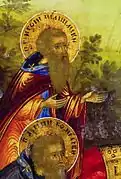 |
Venerable Gregory of the River Pelshma (☦ 1442) Преподобный Григорий Пельшемский |
Henoch and pastor; after the death of his parents gave his property to the poor, freed serfs and went to the Nativity Monastery near Lake Galichskoye; ghostly father of Yuri of Zvenigorod; for a short time hegumen of the Saviour Monastery, moved to the woods of Vologda, went to the Sosnovetsky Monastery, where he met Dionysius of the River Glushitsa; founded the Pelshema Monastery by the Pelshma River; tried to conciliate Yuri of Zvenigorod and Vasily II; in very old age cloistered himself by the Pelshma and built kellions; died at age 127 | 30 September 13 October 19th Week after Pentecost Седмица 19-я по Пятидесятнице |
1549 (church-wide)[11] | [29] |
| 3 | Venerable Jakob of the Iron Pinery (☦ 1442) Преподобный Иаков Железноборовский |
Became monk at Sergius of Radonezh's Monastery; cloistered himself into the Zhelezny Borok (Iron Pinery) forest; founded the John the Baptist Monastery; restored it after Mongol-Tatar raids, helped victims; in late years hegumen; foretold birth of Grand Prince Vasily II of Moscow | 11 April 24 April Bright Week Светлая седмица – сплошная |
c. 1628[237] | [215] | |
| 3 | 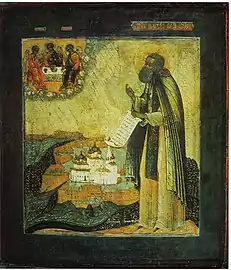 |
Venerable Macarius of Yellow Waters and Unzha (☦ 1444) Преподобный Макарий Желтоводский, Унженский |
Henoch of the Pechersky Ascension Monastery; ascetic; built by the Wolga River a kellion and later the Epiphany Monastery; founded the Makaryev Monastery on the mouth of the Kershenets River; preached Christianity to Mordvins, Tatars, Mari and Chuvash; at old age founded the Makaryeva Monastery near Unzha River | 25 July 7 August 9th Week after Pentecost Седмица 9-я по Пятидесятнице |
1619 (church-wide)[12] | [251] |
| 3 | Venerable Barnabas of the River Vetluga (of Kostroma) (☦ 1445) Преподобный Варнава Ветлужский (Костромской) |
Cleric of Veliky Ustyug and Vologda; became hermit and settled on the coast of the River Vetluga; self-discipline when taking food, ate grass and rarely bread | 11 June 24 June 3rd Week after Pentecost Седмица 3-я по Пятидесятнице |
1639 (local)[252] | [253] | |
| 6 | 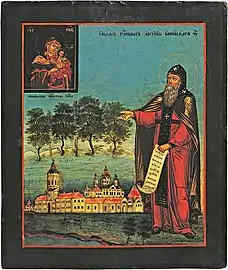 |
Venerable Arsenius of Konevets (☦ 1447) Преподобный Арсений Коневецкий (Коневский) |
Henoch of the Valaam Monastery; when travelling to the Athon opened a monastery at the North; after storm moved to the Konevets Island, cast out demons and founded the Konevsky Monastery there | 12 June 25 June 3rd Week after Pentecost Седмица 3-я по Пятидесятнице |
1981 (church-wide)[17] | [254] |
| 1 | Enlightener Ephraim of Rostov (☦ 1454) Святитель Ефрем, архиепископ Ростовский |
Archbishop of Rostov; founded the Trinity-Sergiev Varnitsky Monastery | 27 March 9 April 6th Week of the Great Lent (Palm Week) Седмица 6-я Великого поста (седмица ваий) |
c. 1423 (local)[255] | [256] | |
| 2 | 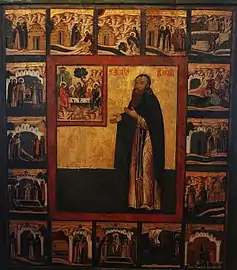 |
Venerable Michael of Klopsk (☦ 1454) Преподобный Михаил Клопский, Христа ради юродивый |
Monk of the Klopsky Monastery; ascetic and Fool-for-Christ; prophet and fortuneteller | 11 January 24 January 31st Week after Pentecost Седмица 31-я по Пятидесятнице |
1547 (church-wide)[11] | [257] |
| 4 | Venerable Joasaph Kamensky (Spasokubensky) of Vologda (☦ 1457) Преподобный Иоасаф Каменский, или Спасокубенский, Вологодский чудотворец |
Son of Prince Dmitry Vasilyevich of Zaozersk; took monastic vows at the Kamenny Monastery; wondermaker | 10 September 23 September 16th Week after Pentecost Седмица 16-я по Пятидесятнице |
1841 (church-wide) 1457 (local)[258] |
[259] | |
| Venerable Philip of Rabangа (☦ 1457) Преподобный Филипп Рабангский |
Student of Dionysius of the River Glushitsa; Amphilochius as hegumen; hermit by the Sukhona River; founded the Transfiguration Rabangsky Monastery | 15 November 28 November 25th Week after Pentecost Седмица 25-я по Пятидесятнице |
? | [260] | ||
| 2 | 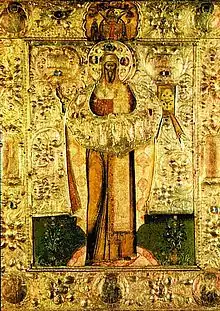 |
Enlightener Euthymius of Novgorod (☦ 1458) Святитель Евфимий, архиепископ Новгородский |
Archbishop of Novgorod; John at early age went to the Vyazhishchsky Monastery and became Euthymius; built churches in Novgorod, helped the poor, enlightened people | 11 March 24 March 4th Week of the Great Lent Седмица 4-я Великого поста |
1549[261] | [262] |
| 6 | Venerable Paisius of Galich (☦ 1460) Преподобный Паисий Галичский |
Hegumen of the Uspensko-Nikolayevsky Monastery of Galich | 23 May 5 June 7th Week after Pascha Седмица 7-я по Пасхе |
1981 (church-wide)[17][263] | [46] | |
| 2 | 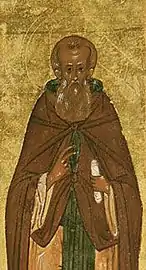 |
Venerable Sabbas Stylites of Vishera, wondermaker of Novgorod (☦ 1460) Преподобный Савва, Вишерский столпник, Новгородский чудотворец |
Pillar saint; founded the Savvo-Vishersky Monastery | 1 October 14 October 19th Week after Pentecost Седмица 19-я по Пятидесятнице |
1549 (church-wide)[74] 1464 (local)[11] |
[264] |
| 2 | 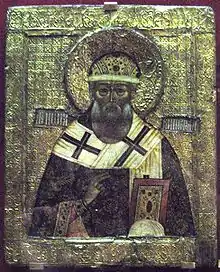 |
Enlightener Metropolitan Jonah of Moscow and all Rus (☦ 1461) Святитель Иона, митрополит Московский и Всея России, Чудотворец |
38th and last Metropolitan of Kiev (cathedra based in Moscow), Metropolitan of all Rus; at early age became monk at a monastery at the village Unorozh, near Galich, then moved to the Simonov Monastery, where he became baker; episcope of Ryazan and Murom; during his term the Russian Church became factually autocephalous | 31 March 13 April 6th Week of the Palm Week (Palm Sunday, Fig Sunday) Седмица 6-я ваий (цветоносная, Вербное воскресенье) |
1547 (church-wide) 1472 (local)[11] |
[265] |
| 3 | 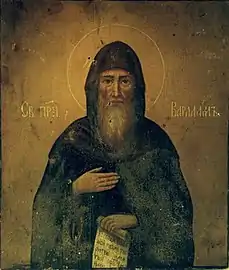 |
Venerable Barlaam of the Vaga (of Shenkursk) (☦ 1462) Преподобный Варлаам Важский, или Шенкурский |
Vasily, son of boyars; preached Christianity to the pagans of the North (now in Arkhangelsk Oblast); founded a monastery by the Vaga River | 19 June 2 July 4th Week after Pentecost Седмица 4-я по Пятидесятнице |
1630[266] | [267] |
| 6 | Enlightener Tryphon of Rostov (☦ 1468) Святитель Трифон, епископ Ростовский |
Archbishop of Rostov and Yaroslav; archimandrit of the Novospassky Monastery; ghostly father of Grand Prince Vasily II of Moscow | 1 February 14 February Fast-free week Седмица сплошная |
1964 (church-wide)[219] | [268] | |
| 2 | Enlightener Jonah of Novgorod (☦ 1470) Святитель Иона, архиепископ Новгородский |
Archbishop of Novgorod; hegumen of the Otinskaya Monastery; restored the Dmitriev Monastery of Novgorod; prevented assassination of Grand Prince Vasily II of Moscow by conspirators; founded and built several churches | 5 November 18 November 24th Week after Pentecost Седмица 24-я по Пятидесятнице |
1549[261] | [269] | |
| 3 | Venerable Euthymius of the Syanzhema (☦ 1470) Преподобный Евфимий Сянжемский |
Monk of the Kamenny Monastery; hermit by the Kushta River, when meeting Alexander of the Kushta River moved to the coast of the River Syanzhemki; after students came to him founded the Feast of Ascension Monastery | 20 January 2 February 32nd Week after Pentecost Седмица 32-я по Пятидесятнице |
1549–1721, 1841 (church-wide)[270] | [271] | |
| 5 | Hieromartyr Isidorе the Presbyter and with him 72 martyrs of Yuryev (☦ 1472) Священномученик Исидор Пресвитер и иже с ним 72 мученика Юрьевских |
Presbyter Isidore and with him 72 Orthodox Christians were martyred in the German-occupied city of Yuryev for refusing to convert to Roman Catholicism | 8 January 21 January 31st Week after Pentecost Седмица 31-я по Пятидесятнице |
1897 (local)[15] | [53] | |
| 3 | Blessed Isidorе Tverdislov of Rostov (☦ 1474) Блаженный Исидор Твердислов, Христа Ради Юродивый, Ростовский чудотворец |
Tverdislov means firm word person; Ascetic from Prussia, turning Orthodox; wondermaker, Fool-for-Christ | 14 May 27 May 6th Week after Pascha Седмица 6-я по Пасхе |
1549 (church-wide)[39] |
[272] | |
| 6 | Venerable Hilarion of Pskov (Gdov) (☦ 1476) Преподобный Иларион Псковоезерский, Гдовский |
Student of Euphrosynus of Pskov; founder and first hegumen of the Ozersky Pokrovsky Monastery near Gdov | 28 March 10 April 6th Week of the Great Lent (Palm Week) Седмица 6-я Великого поста (седмица ваий) |
1987 (church-wide)[17] | [56] | |
| 2 | 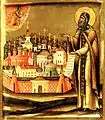 |
Venerable Paphnutius of Borovsk (☦ 1477) Преподобный Пафнутий Боровский |
Parfeny took the monastic vows and became Paphnutius; spiritual son of Nikita of Serpukhov, who was student of Sergius of Radonezh; hegumen of the Intercession Monastery; left to the forest where the Paphnutius of Borovsk Monastery was founded; known for his benevolence | 1 May 14 May 4th Week after Pascha Седмица 4-я по Пасхе |
1547 (church-wide) 1531 (local)[11] |
[273] |
| 2 | 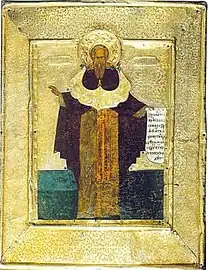 |
Venerable Zosima of Solovki (☦ 1478) Преподобный Зосима, игумен Соловецкий |
Hegumen; with Herman of Solovki built a kellion, churches and a monastery on the Solovetsky Islands; one of the founders of the Solovetsky Monastery | 17 April 30 April 2nd Week after Pascha Седмица 2-я по Пасхе |
1547 (church-wide) around 1503 (local)[11] |
[274] |
| 3 | 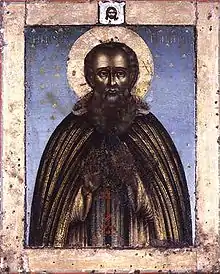 |
Venerable Herman of Solovki (☦ 1479) Преподобный Герман Соловецкий |
Hermit of Belomorye near a chapel; once wanted to be stranded on the Solovetsky Islands, met Zosima of Solovki and built there a kellion, churches and a monastery on the Solovetsky Islands; one of the founders of the Solovetsky Monastery | 30 July 12 August 10th Week after Pentecost Седмица 10-я по Пятидесятнице |
1690 or 1691 (local)[275] | [276] |
| 3 | 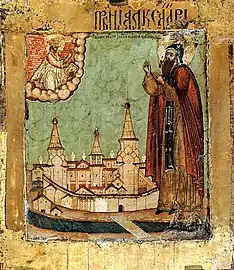 |
Venerable Alexander Osheven (☦ 1479) Преподобный Александр Ошевенский |
Monk; known to the world Alexey, took monastic vows at the Kirillo-Belozersky Monastery; founder and first hegumen of the Alexandro-Oshevensky Monastery | 20 April 2 May 2nd Week after Pascha Седмица 2-я по Пасхе |
1577–80 (local)[277] | [278] |
| Venerable Macarius of the Glushitsa (☦ 1480) Преподобный Макарий Глушицкий |
Matthew, son of Dionysius of Rostov; Macarius later became presbyter of a monastery | 13 October 26 October 20th Week after Pentecost Седмица 20-я по Пятидесятнице |
?[279] | [280] | ||
| 6 | Venerable Serapion of Spaso-Eleasarovsky (☦ 1480) Преподобный Серапион Спасоелеазаровский |
Henoch; when meeting ven. Eleazar became hermit; prophesied the failed German raid of 1480; cured people | 8 September 21 September 15th Week after Pentecost, before the Feast of the Cross Седмица 15-я по Пятидесятнице, перед Воздвижением |
1987 (church-wide)[17] | [281] | |
| 2 | 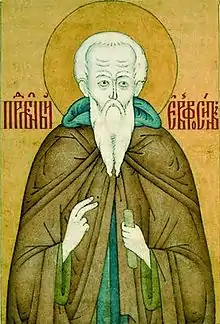 |
Venerable Euphrosynus of Pskov, baptized Eleazar (☦ 1481) Преподобный Евфросин, во Святом Крещении Елеазар, Псковский |
Monk from Snetogorsky Monastery; founded a monastic community near Pskov | 15 May 28 May 6th Week after Pascha Седмица 6-я по Пасхе |
1549 (church-wide)[74] 1st half of the 16th century (local)[11] |
[52] |
| 5 | Venerable Antonius of Krasnу Kholm (☦ 1481) Преподобный Антоний Краснохолмский |
Hieromonk of the Kirillo-Belozersky Monastery; founded the St. Nicholas Monastery | 17 January 30 January 32nd Week after Pentecost Седмица 32-я по Пятидесятнице |
1979 (church-wide) 1904 (local)[282] |
[121] | |
| 1 | Enlightener Bassian I of Rostov (☦ 1481) Святитель Вассиан I, Архиепископ Ростовский |
Archbishop of Rostov and Yaroslav; relative of Joseph Volotsky, favourite student of Paphnutius of Borovsk; henoch of the St. Sergius Trinity Monastery, archmandrite of the Novospassky Monastery; didactive, built churches in Rostov | 23 March 5 April 5th Week of the Great Lent. Feast of the Annunciation (Sunday of the Akafist) Седмица 5-я Великого поста. Похвала Пресвятой Богородицы (Суббота Акафиста) |
1481 (church-wide) 1964 (local)[283] |
[49] | |
| 1 | Venerable Dositheus of the High Lake (☦ 1482) Преподобный Досифей Верхнеостровский |
Hieromonk; student of Euphrosyne of Pskov; founded the St. Peter and Paul Monastery on the island within the High Pskovian Lake | 8 October 21 October 20th Week after Pentecost Седмица 20-я по Пятидесятнице |
1481-2 (church-wide) 1987 (local)[284] |
[285] | |
| 2 |  |
Venerable Macarius of Kalyazin (of Kolyazin) (☦ 1483) Преподобный Макарий Калязинский (Колязинский) |
Hegumen, Matthew to the world; took monastic vows at the Nikolayevsky Klobukovsky Monastery; founded the Trinity Kalyazinsky Monastery, named after boyar and future henoch Ivan Kolyaga; built churches | 17 March 30 March 4th Week of the Great Lent Седмица 4-я Великого поста |
1547 (church-wide) 1521 (local)[11] |
[286] |
| 3 | Venerable Martinian of Beloozero (☦ 1483) Преподобный Мартиниан Белоезерский (Белозерский) |
Hegumen; took monastic vows at the Kirillo-Belozersky Monastery, follower of Kirill of Belozersk; in late years founded the Bozheozersky Saviour Monastery; once when Vasily II visited the monastery, Martinian blessed him and foresaw his great rule, became his personal priest; became hegumen of the St. Sergius Trinity Monastery | 12 January 25 January 31st Week after Pentceost. Sunday after the Holy Manifestation Седмица 31-я по Пятидесятнице. Суббота пo Богоявлении |
(1553) (church-wide)[242] | [287] | |
| 1 | Enlightener Metropolitan Gerontius of Moscow (☦ 1489) Святитель Геронтий, митрополит Московский |
41st Metropolitan of all Rus, 3rd Metropolitan of Moscow; hegumen of the Simonov Monastery and episcope of Kolomensk; helped to build and reconstruct religious buildings, including the Metropolitan House and the Dormition Cathedral in the Moscow Kremlin | 28 May 10 June 1st Week after Pentecost, fast-free week Седмица 1-я по Пятидесятнице, сплошная |
late 15th century (church-wide) 2001 (local)[288] |
[148] | |
| 5 | Venerable Tikhon of Medyn (Kaluga) (☦ 1492) Преподобный Тихон Медынский, или Калужский |
Henoch of Moscow; hermit in the area around Medyn, near Kaluga; ate only grass and drank water from a well; several students came to him, including Photius and Gerasim; wondermaker | 16 June 29 June 3rd Week after Pentecost Седмица 3-я по Пятидесятнице |
1909 (church-wide) 1533–1584 (local)[15] |
[222] | |
| 2 | 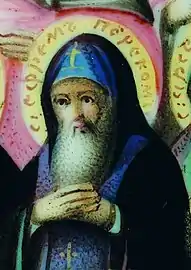 |
Venerable Ephraim of Perekom (☦ 1492) Преподобный Ефрем Перекомский |
Ephraim, known to the world Eustathius; became monk at the Kalyazinsky Monastery; took monastic vows at the Savvo-Vishersky Monastery and cloistered himself by the Ilmen Lake, where he founded the Perekamsky Monastery | 16 May 29 May 6th Week after Pascha Седмица 6-я по Пасхе |
1549 (church-wide)[74] 1st half of the 16th century (local)[11] |
[289] |
| 6 | 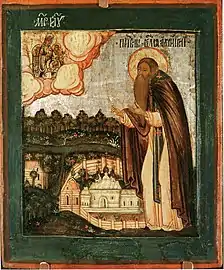 |
Venerable Cosmas of the Yakhroma (☦ 1492) Преподобный Косма Яхромский |
Once when hearing a voice by the Yakhroma River and seeing a Dormition of the Mother of God icon on a tree, became monk at the Kiev Caves Monastery; returned and founded the Kosma of Yakhroma Monastery | 18 February 3 March 1st Week of the Great Lent Седмица 1-я Великого поста |
1982 (church-wide)[17] | [290] |
| 6 | Venerable Leontius of Karakhov (of Karikhov) (☦ 1492/1429) Преподобный Леонтий Караховский (Кариховский) |
Founded the Karakhovsky Monastery in Novgorod | 18 July 31 July 8th Week after Pentecost Седмица 8-я по Пятидесятнице |
1981 (local)[17] | [90] | |
| 6 | Venerable Nectarius of Bezhetsk (☦ 1492) Преподобный Нектарий Бежецкий |
Founded the Presentation Monastery in Tver | 3 April 16 April Holy Week Страстная седмица |
1979 (church-wide) 1904 (local)[291] |
[292] | |
| 3 | 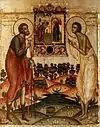 |
Blessed John of Ustyug (☦ 1494) Блаженный Иоанн, Христа ради Юродивый, Устюжский Чудотворец |
At early age, influenced by his mother and future nun, moved to Veliky Ustyug and stayed near the Dormition church; Fool for Christ, wondermaker; healed Maria, wife of Prince Theodore the Red | 29 May 11 June 1st Week after Pentecost, fast-free week Седмица 1-я по Пятидесятнице (сплошная) |
1647 (church-wide) 1547 (local)[12] |
[216] |
| 3 | Venerable Sabbas of the Lake Krypets (Pskov) (☦ 1495) Преподобный Савва Крыпецкий (Псковский) |
Serbian henoch who moved to Russia; became monk at the Snetogorsky Monastery in Pskov, then moved near the Tolva River with assistance of Euphrosyne of Pskov and finally near the Krypets Lake; built the St. John church; healed voivode Yaroslav Vasilyevich Obolensky's wife | 28 August 10 September 14th Week after Pentecost Седмица 14-я по Пятидесятнице |
1554 (local)[198] | [62] | |
| 4 | Hieromartyr Metropolitan Macarius of Kiev (☦ 1497) Священномученик Макарий, Митрополит Киевский |
Metropolitan of Kiev; became archimandrite of the Holy Trinity Monastery of Vilnius; shortly before another one of the seemingly endless Tatar raids stayed in Kiev and ordered the people to secure themselves; they found him near the altar headless | 1 May 14 May 4th Week after Pascha Седмица 4-я по Пасхе |
1762 (church-wide) 1643 (local)[14] |
[273] | |
- Translation of the relics, by the order of Elizabeth I
- From 12–21 February 1677 Patriarch Joachim ordered to investigate the sainthood of Anna of Kashin, particularly the fact of healing from her relics; her following de-canonization was supported by the 1678–1679 Councils, but services were allowed. Thirteen errors were found in documents like her Lives of Saints, including her supposed ancestry from "glorious boyars". However, local honourings of Anna of Kashin did not stop, and several healings were recorded.
- On 7 November 1908, the Most Holy Synod recovered her church-wide canonization.
- Synaxis of All Saints of Vologda
- Synaxis of All Saints of Karelia
- Synaxis of All Saints of Novgorod
- Sabbatius
- Only Euthymius, under All Russian Saints
- All three, under Nikolo-Korelsk Saints
- Synaxis of All Saints of Kola
- Synaxis of All Saints of Karelia
See also
Notes
- Andronik (Trubachov). Канонизация святых в Русской Православной Церкви – Содержание [Canonization of Saints by the Russian Orthodox Church – Index] (in Russian). Азбука веры (The Faith Alphabet).
- Macarius (Bulgakov). История Русской Церкви – Глава 1. Проповедь святого апостола Андрея в наших странах [History of the Russian Church – Chapter 1. The Preachings of Apostle Andrew in our Lands] (in Russian). Азбука веры (The Faith Alphabet).
- Macarius (Bulgakov). История Русской Церкви – Глава 2. Церковь Христова в Древней Скифии или нынешнем Новоросийском крае [History of the Russian Church – Chapter 2. The Church of Christ in Ancient Scythia or Today's Novorossysk Krai] (in Russian). Азбука веры (The Faith Alphabet).
- Macarius (Bulgakov). "История Русской Церкви – Глава II. Начатки христианства в Царстве Русском со времени основания его до равноапостольной княгини Ольги" [History of the Russian Church – Chapter II. The Early Years of Christianity in the Russian Tsardom During its Establishment Before Equal-to-apostles Princess Olga] (in Russian). Азбука веры (The Faith Alphabet).
- Macarius (Bulgakov). "История Русской Церкви – Глава III. Состояние христианства в царстве Русском при великой княгине Ольге и по смерти её до обращения великого князя Владимира" [History of the Russian Church – Chapter III. Christianity in the Russian Tsardom under Grand Princess Olga until Her Death and Early Ruling Years of Prince Vladimir Before His Conversion] (in Russian). Азбука веры (The Faith Alphabet).
- Macarius (Bulgakov). "История Русской Церкви – Глава IV. Обращение к христианству великого князя Владимира" [History of the Russian Church – Chapter III. Conversion to Christianity of Grand Prince Vladimir] (in Russian). Азбука веры (The Faith Alphabet).
- Macarius (Bulgakov). История Русской Церкви – Предисловие [History of the Russian Church – Introduction] (in Russian). Азбука веры (The Faith Alphabet).
- Aleksandr Rudakov. "Краткая история христианской церкви – 38. Правление митрополитов: святых Кирилла II, Петра и Алексия; перенесение митрополичьей кафедры из Киева во Владимир и потом в Москву" [Short History of the Christian Church – 38. The Rule of Metropolitans, St. Cyril II, Peter and Alexius; Move of Metropolitan Cathedras from Kiev to Vladimir and then to Moscow] (in Russian). Азбука веры (The Faith Alphabet).
- Московская Епархия [Moscow Eparchy] (in Russian). Open Orthodox Encyclopedia "Drevo-Info". Archived from the original on 30 June 2014. Retrieved 9 June 2014.
- Macarius (Bulgakov). "История Русской Церкви – Глава I" [History of the Russian Church – Chapter I] (in Russian). Азбука веры (The Faith Alphabet).
- Andronik (Trubachov). Канонизация святых в Русской Православной Церкви – 2. Канонизация русских святых на Соборах 1547-го и 1549 гг. [Canonization of Saints by the Russian Orthodox Church – 2. Canonization of Saints from 1547 – 1549] (in Russian). Азбука веры (The Faith Alphabet).
- Andronik (Trubachov). Канонизация святых в Русской Православной Церкви – 3. Канонизация святых в 1550–1721 гг. [Canonization of Saints by the Russian Orthodox Church – 3. Canonization of Saints from 1550 – 1721] (in Russian). Азбука веры (The Faith Alphabet).
- V.M. Zhivov. Святость. Краткий словарь агиографических терминов — Алфавитный указатель [Sainthood. Short Dictionary of Hagiographical Terms – Alphabetical Index] (in Russian). Азбука веры (The Faith Alphabet).
- Andronik (Trubachov). Канонизация святых в Русской Православной Церкви – 4. Канонизация святых в 1721–1894 гг. [Canonization of Saints by the Russian Orthodox Church – 4. Canonization of Saints from 1721 – 1894] (in Russian). Азбука веры (The Faith Alphabet).
- Andronik (Trubachov). Канонизация святых в Русской Православной Церкви – 5. Канонизация святых в 1894–1917 гг. [Canonization of Saints by the Russian Orthodox Church – 5. Canonization of Saints from 1894 – 1917] (in Russian). Азбука веры (The Faith Alphabet).
- История Русской Церкви (Синодальный период) [History of the Russian Church (Synodal period)] (in Russian). Азбука веры (The Faith Alphabet).
- Andronik (Trubachov). Канонизация святых в Русской Православной Церкви – 6. Канонизация святых в 1917–1987 гг. [Canonization of Saints by the Russian Orthodox Church – 6. Canonization of Saints from 1917 – 1987] (in Russian). Азбука веры (The Faith Alphabet).
- Andronik (Trubachov). Канонизация святых в Русской Православной Церкви – 7. Канонизация святых после 1988 г. [Canonization of Saints by the Russian Orthodox Church – 7. Canonization of Saints after 1988] (in Russian). Азбука веры (The Faith Alphabet).
- Andronik (Trubachov). "Канонизация святых в Русской Православной Церкви – 1. Канонизация святых в XI в.— 1547 г." [Canonization of Saints by the Russian Orthodox Church – 1. Canonization of Saints from 11th century – 1547] (in Russian). Азбука веры (The Faith Alphabet).
- Лик святости [Saint Titles] (in Russian). Азбука веры (The Faith Alphabet).
- Классификация святых [Classification of Saints] (in Russian).
- Nikolay Solntsev (13 December 2013). Апостол Андрей Первозванный – просветитель земли Русской [Apostle Andrew the First-called – Enlightener of the Russian Land] (in Russian). pravoslavie.ru.
- Седмица 27-я по Пятидесятнице
- Седмица 3-я Великого поста
- Седмица сырная (масленица) – сплошная
- Седмица 5-я по Пасхе
- Седмица 7-я по Пятидесятнице
- Седмица 7-я по Пятидесятнице
- Седмица 19-я по Пятидесятнице
- Георгий Угрин [George the Hungarian] (in Russian). Православная Энциклопедия (The Orthodox Encyclopedia).
- Седмица сплошная
- Седмица 8-я по Пятидесятнице
- Седмица 9-я по Пятидесятнице
- Феодор, епископ Ростовский и чудотворец Cуздальский, святитель
- Седмица 2-я по Пятидесятнице
- Седмица 9-я по Пятидесятнице
- Анна [Anna] (in Russian). Православная Энциклопедия (The Orthodox Encyclopedia).
- Неделя мясопустная, о Страшнем суде
- Golubinsky, p. 108
- Golubinsky, pp. 73–74
- Седмица 19-я по Пятидесятнице
- Golubinsky, p. 117
- Седмица 26-я по Пятидесятнице
- Седмица 19-я по Пятидесятнице
- Седмица 7-я по Пятидесятнице
- Седмица 7-я по Пасхе
- Ярополк Изяславич Владимиро-Волынский, святой благоверный князь
- Седмица 26-я по Пятидесятнице
- Седмица 5-я Великого поста. Похвала Пресвятой Богородицы (Суббота Акафиста)
- Иоанн [John] (in Russian). Православная Энциклопедия (The Orthodox Encyclopedia).
- Седмица 14-я по Пятидесятнице
- Седмица 6-я по Пасхе
- Седмица 31-я по Пятидесятнице
- Седмица 3-я по Пасхе
- Седмица 1-я по Пятидесятнице (сплошная)
- Седмица 6-я Великого поста (седмица ваий)
- Седмица 11-я по Пятидесятнице
- Golubinsky, p. 118
- Седмица 29-я по Пятидесятнице
- Golubinsky, p. 82
- Седмица 23-я по Пятидесятнице
- Седмица 14-я по Пятидесятнице
- Седмица сплошная
- Седмица 11-я по Пятидесятнице
- Седмица 22-я по Пятидесятнице
- Седмица 21-я по Пятидесятнице
- Амфилохий [Amphilochius] (in Russian). Православная Энциклопедия (The Orthodox Enclyclopedia).
- Седмица 20-я по Пятидесятнице
- Седмица 14-я по Пятидесятнице
- Седмица 11-я по Пятидесятнице
- Седмица 31-я по Пятидесятнице, по Рождестве Христовом
- Седмица 7-я по Пасхе
- Седмица 2-я по Пасхе
- Golubinsky, p. 104
- Седмица сырная (масленица) – сплошная
- Седмица 21-я по Пятидесятнице
- Golubinsky, p. 107
- Golubinsky, p. 58
- Седмица 17-я по Пятидесятнице
- Седмица 6-я по Пятидесятнице
- Golubinsky, p. 119
- Седмица 10-я по Пятидесятнице
- Седмица 24-я по Пятидесятнице
- Светлая седмица – сплошная
- Авраамий Мирожский [Abraham of Mirozh] (in Russian). Православная Энциклопедия (The Orthodox Enclyclopedia).
- Седмица 18-я по Пятидесятнице
- Golubinsky, p. 139
- Седмица 2-я по Пятидесятнице
- Седмица 1-я Великого поста. Торжество Православия
- Седмица 8-я по Пятидесятнице
- Аркадий [Arkadius] (in Russian). Православная Энциклопедия (The Orthodox Enclyclopedia).
- Седмица 17-я по Пятидесятнице
- Седмица 4-я Великого поста
- Седмица 22-я по Пятидесятнице
- Golubinsky, p. 134
- Седмица 4-я по Пятидесятнице
- Евфросиния [Euphrosyne] (in Russian). Православная Энциклопедия (The Orthodox Encyclopedia).
- Седмица 6-я по Пятидесятнице
- Седмица 28-я по Пятидесятнице
- Golubinsky, p. 140
- Седмица 3-я Великого поста
- Golubinsky, p. 74
- Седмица 3-я по Пятидесятнице
- Седмица 4-я по Пасхе, о расслабленом
- Седмица 15-я по Пятидесятнице. Суббота перед Воздвижением
- Седмица 30-я по Пятидесятнице
- Седмица 2-я Великого поста
- Седмица 24-я по Пятидесятнице
- Седмица сплошная
- Страстная седмица
- Седмица 11-я по Пятидесятнице
- Седмица 4-я по Пасхе
- Седмица 29-я по Пятидесятнице
- Седмица 30-я по Пятидесятнице
- Седмица 32-я по Пятидесятнице
- Седмица 3-я по Пасхе
- Седмица 8-я по Пятидесятнице
- 22 январь
- Седмица 23-я по Пятидесятнице
- Седмица 20-я по Пятидесятнице
- Седмица 32-я по Пятидесятнице
- Седмица 13-я по Пятидесятнице
- Седмица 5-я по Пятидесятнице
- Седмица 5-я по Пасхе
- Седмица 5-я по Пятидесятнице
- Страстная седмица
- Golubinsky, pp. 122–3
- Golubinsky, p. 141
- Седмица 26-я по Пятидесятнице
- 4 февраля
- Евпраксия [Eupraksia] (in Russian). Православная Энциклопедия (The Orthodox Encyclopedia).
- Седмица 21-я по Пятидесятнице
- Седмица 5-я по Пасхе, о самаряныне
- Golubinsky, p. 62
- Седмица 17-я по Пятидесятнице
- Елисей [Elischa] (in Russian). Православная Энциклопедия (The Orthodox Encyclopedia).
- Седмица 22-я по Пятидесятнице
- Golubinsky, p. 84
- Golubinsky, p. 115
- Седмица 18-я по Пятидесятнице
- Седмица о блудном сыне
- Седмица 5-я по Пятидесятнице
- Седмица 26-я по Пятидесятнице
- Golubinsky, p. 196
- Седмица 8-я по Пятидесятнице
- Соборы святых всея Руси [Synaxes of Saints all of Russia] (in Russian). Tatiana Day. Retrieved 15 June 2014.
- Седмица 18-я по Пятидесятнице
- Седмица 1-я по Пятидесятнице, сплошная
- Golubinsky, pp. 110–111
- Седмица 5-я по Пятидесятнице
- Golubinsky, p. 122
- Седмица 6-я по Пятидесятнице
- Иоасаф [Joasaphus] (in Russian). Православная Энциклопедия (The Orthodox Encyclopedia).
- Golubinsky, pp. 76–78
- Golubinsky, p. 71
- Седмица 7-я по Пасхе
- Возрождение [Revival] (in Russian). Bryansk and Sevsk eparchy. Retrieved 15 June 2014.
- Седмица 10-я по Пятидесятнице
- Седмица 5-я Великого поста
- Афанасий Череповецкий [Athanasius of Cherepovets] (in Russian). Православная Энциклопедия (The Orthodox Encyclopedia).
- Седмица 31-я по Пятидесятнице
- Гедеон [Gedeon] (in Russian). Православная Энциклопедия (The Orthodox Encyclopedia).
- Седмица 24-я по Пятидесятнице
- Golubinsky, p. 190
- Седмица 7-я по Пятидесятнице
- Седмица 28-я по Пятидесятнице
- Golubinsky, p. 142
- Седмица 31-я по Пятидесятнице
- Golubinsky, p. 67
- Седмица 30-я по Пятидесятнице. Суббота перед Рождеством Христовым
- Седмица 4-я по Пятидесятнице
- Седмица 18-я по Пятидесятнице
- Golubinsky, p. 130
- Анна Кашинская [Anna of Kashin] (in Russian). Православная Энциклопедия (The Orthodox Encyclopedia).
- Седмица 19-я по Пятидесятнице
- Седмица 2-я по Пасхе (Антипасха)
- Golubinsky, pp. 191–4
- Golubinsky, p. 145
- 25 январь
- Седмица 28-я по Пятидесятнице
- Golubinsky, pp. 143–5
- Седмица 21-я по Пятидесятнице
- Golubinsky, p. 111
- Седмица 8-я по Пятидесятнице
- Седмица cырная (масленица) – сплошная
- Седмица 2-я по Пасхе. Радоница. Поминовение усопших
- Седмица 2-я по Пасхе
- Дионисий [Dionysius] (in Russian). Православная Энциклопедия (The Orthodox Encyclopedia).
- Седмица 5-я по Пятидесятнице
- Седмица 5-я по Пасхе
- Седмица 7-я по Пасхе, святых отцев I Вселенского Собора
- Golubnisky, p. 146
- Седмица 2-я по Пятидесятнице
- Valery Dukhanin (15 May 2014). Будет он обителью и слугой Святой Троицы [May He Become a Place and Servant of the Holy Trinity] (in Russian). pravoslavie.ru.
- Olga Glagoleva (5 October 2006). Игумен всея Руси [Hegumen of all Rus'] (in Russian). pravoslavie.ru.
- Седмица 27-я по Пятидесятнице
- Taisia (Kartsova). Собор Владимирских святых [Synaxis of All Saints of Vladimir] (in Russian). Sedmitza – Church-Scientific Centre "The Orthodox Encyclopedia". Retrieved 14 June 2014.
- Golubinsky, p. 112
- Седмица 3-я по Пятидесятнице
- Афанасий Высоцкий [Athanasius Vysotsky] (in Russian). Православная Энциклопедия (The Orthodox Encyclopedia).
- Седмица 16-я по Пятидесятнице
- Андроник Московский, Спасский [Andronikos of Moscow, Spassky] (in Russian). Православная Энциклопедия (The Orthodox Encyclopedia). Retrieved 15 June 2014.
- Седмица 3-я по Пятидесятнице
- Седмица 27-я по Пятидесятнице
- Golubinsky, p. 81
- Седмица 3-я по Пасхе
- Golubinsky, p. 152
- Афанасий Муромский [Athanasius of Murom] (in Russian). Православная Энциклопедия (The Orthodox Encyclopedia).
- Седмица 3-я Великого поста
- Андрей Рублёв [Andrey Rublev] (in Russian). Православная Энциклопедия (The Orthodox Encyclopedia).
- Георгий [George] (in Russian). Православная Энциклопедия (The Orthodox Encyclopedia).
- Амфилохий Глушицкий [Amphilochius of Glushitsa] (in Russian). Православная Энциклопедия (The Orthodox Encyclopedia).
- Седмица 20-я по Пятидесятнице
- Иаков [Jacob] (in Russian). Православная Энциклопедия (The Orthodox Encyclopedia).
- Светлая седмица – сплошная
- Седмица 1-я по Пятидесятнице (сплошная)
- Васса [Vassa] (in Russian). Православная Энциклопедиа (The Orthodox Encyclopedia).
- Седмица 6-я Великого поста (седмица ваий)
- Taisia (Kartsova). Собор Ростово-Ярославских святых [Synaxis of All Saints of Rostov and Yaroslav] (in Russian). Sedmitza – Church-Scientific Centre "The Orthodox Encyclopedia". Retrieved 14 June 2014.
- Седмица 22-я по Пятидесятнице
- Седмица 10-я по Пятидесятнице
- Седмица 3-я по Пятидесятнице
- Седмица 1-я Великого поста
- Авраамий и Коприй Печенгские [Abraham and Koprius of Pechenga] (in Russian). Православная Энциклопедиа (The Orthodox Encyclopedia).
- Авраамий Палеостровский [Eleazar, Nazarius and Eumenius] (in Russian). Православная Энциклопедиа (The Orthodox Encyclopedia).
- Елеазар, Назарий и Евмений [Eleazar, Nazarius and Eumenius] (in Russian). Православная Энциклопедиа (The Orthodox Encyclopedia).
- Седмица 2-я Великого поста. Поминовение усопших
- Афанасий Высоцкий [Athanasius of Vysotsky] (in Russian). Православная Энциклопедиа (The Orthodox Encyclopedia).
- Иулиания [Juliana] (in Russian). Православная Энциклопедиа (The Orthodox Encyclopedia).
- Седмица 17-я по Пятидесятнице
- Golubinsky, p. 113
- Память святых отцев шести Вселенских Соборов
- Седмица 28-я по Пятидесятнице
- Евдокия Димитриевна [Eudoxia of Moscow] (in Russian). Православная Энциклопедиа (The Orthodox Encyclopedia).
- Седмица 6-я по Пасхе
- Седмица 22-я по Пятидесятнице
- Golubinsky, p. 148
- Седмица 20-я по Пятидесятнице
- Дионисий Грек [Dionysius the Greek] (in Russian). Православная Энциклопедия (The Orthodox Encyclopedia).
- Седмица 21-я по Пятидесятнице
- Седмица 25-я по Пятидесятнице
- Golubinsky, p. 109
- Седмица 1-я по Пятидесятнице (сплошная)
- Седмица 2-я по Пятидесятнице, Всех святых в земле Российской просиявших
- Седмица 6-я по Пятидесятнице
- Седмица 26-я по Пятидесятнице
- Седмица 18-я по Пятидесятнице
- Евфимий [Euthymius] (in Russian). Православная Энциклопедия (The Orthodox Encyclopedia).
- Седмица 2-я по Пасхе
- Golubinsky, p. 120
- Седмица 9-я по Пятидесятнице
- Golubinsky, pp. 127–8
- Седмица 3-я по Пятидесятнице
- Седмица 3-я по Пятидесятнице
- Ефрем [Ephraim] (in Russian). Православная Энциклопедия (The Orthodox Encyclopedia).
- Седмица 6-я Великого поста (седмица ваий)
- Седмица 31-я по Пятидесятнице
- Иоасаф [Joasaph] (in Russian). Православная Энциклопедия (The Orthodox Encyclopedia). Retrieved 18 June 2014.
- Седмица 16-я по Пятидесятнице
- Седмица 25-я по Пятидесятнице
- Golubinsky, p. 103
- Седмица 4-я Великого поста
- Golubinsky, p. 149
- Седмица 19-я по Пятидесятнице
- Седмица 6-я ваий (цветоносная, Вербное воскресенье)
- Варлаам Важский [Varlaam of Vazhsky] (in Russian). Православная Энциклопедия (The Orthodox Encyclopedia).
- Седмица 4-я по Пятидесятнице
- Седмица сплошная
- Седмица 24-я по Пятидесятнице
- Евфимий и Харитон [Euthymius and Chariton] (in Russian). Православная Энциклопедия (The Orthodox Encyclopedia). Retrieved 15 June 2014.
- Седмица 32-я по Пятидесятнице
- Седмица 6-я по Пасхе
- Седмица 4-я по Пасхе
- Седмица 2-я по Пасхе
- Golubinsky, pp. 132–3
- Седмица 10-я по Пятидесятнице
- Golubinsky, p. 150
- Седмица 2-я по Пасхе
- Golubinsky, p. 151
- Седмица 20-я по Пятидесятнице
- Седмица 15-я по Пятидесятнице, перед Воздвижением
- Антоний Краснохолмский [Anthony of Krasnokholmsk] (in Russian). Православная Энциклопедия (The Orthodox Encyclopedia).
- Вассиан [Bassian] (in Russian). Православная Энциклопедия (The Orthodox Encyclopedia).
- Досифей [Dositheus] (in Russian). Православная Энциклопедия (The Orthodox Encyclopedia).
- Седмица 20-я по Пятидесятнице
- Седмица 4-я Великого поста
- Седмица 31-я по Пятидесятнице. Суббота пo Богоявлении
- Геронтий [Gerontius] (in Russian). Православная Энциклопедия (The Orthodox Encyclopedia).
- Седмица 6-я по Пасхе
- Седмица 1-я Великого поста
- Taisia (Kartsova). Собор Тверских Святых [Synaxis of All Saints of Tver] (in Russian). Sedmitza – Church-Scientific Centre "The Orthodox Encyclopedia". Retrieved 14 June 2014.
- Страстная седмица
References
- Golubinsky, Yevgeny Yevsigneyevich (1903). Исторiя канонизацiи святыхъ въ Русской церкви [History of the Canonization of Saints by the Russian Church] (in Russian). Императорское общество исторiи и древности Россiйскихъ при Московскомъ университетѣ (Imperial Community of Russian History and Ancientry of the Moscow University).
- Dmitry of Rostov (1684–1705). V. Osmak (ed.). Житiя святыхъ [Lives of Saints] (in Russian and Church Slavic).
- Kabludovsky, A.P. (1902). Очерки по исторіи древнерусской литературы житій святыхъ [Essays about the History of Old Russian Literature of Lives of Saints] (in Russian). Warsaw.
- Klyuchevsky, Vasily Osipovich (1871). Древнерусскiя житiя святыхъ какъ историческiй источникъ [The Old Russian Lives of Saints as an Historical Source] (in Russian). Moscow: K. Soldatenkova.
- Kovalevsky, I. (1902). Юродство о Христѣ и Христа ради юродивые Восточной и Русской Церкви: Ист. очеркъ и житія сихъ подвижниковъ благочестія [Folly for the Sake of Christ and Fools-for-Christ of the Eastern and Russian Churches] (in Russian). Moscow.
- Nikodim (Kononov) (1903). Къ вопросу о канонизаціи святыхъ въ Русской Церкви [On the Question of Canonization of Saints in the Russian Church] (in Russian). Moscow.
- Serebryansky, Nikolay Ilyich (1915). Древнерусскія княжескіе житія [Lives of Old Russian Monarchs] (in Russian). Moscow.
- Taisia (Kartsova) (2001). Русские святые [Russian Saints] (in Russian). Азбука-классика. Missing or empty
|url=(help) - Vasilyev, V.P. (1893). Очерки по исторіи канонизаціи русскихъ святыхъ [Essays about the History of the Canonization of Russian Saints] (in Russian). Moscow.
- Yakhontov, Ivan Andreyevich (1881). Жiтия св. сѣвернорусскiхъ подвижниковъ Поморскаго края, какъ историческiй источникъ [The Lives of Saints of Ascetics of the Pomorian Krai, as an Historical Source] (in Russian). Kazan.
External links
- Chronological list of Russian saints (in Russian)
- Description of Russian saints (in Russian)
- The Orthodox Encyclopedia (in Russian)
- Saints and sainthood. Canonization of saints (in Russian)
- Description of Canonization by the OCA
